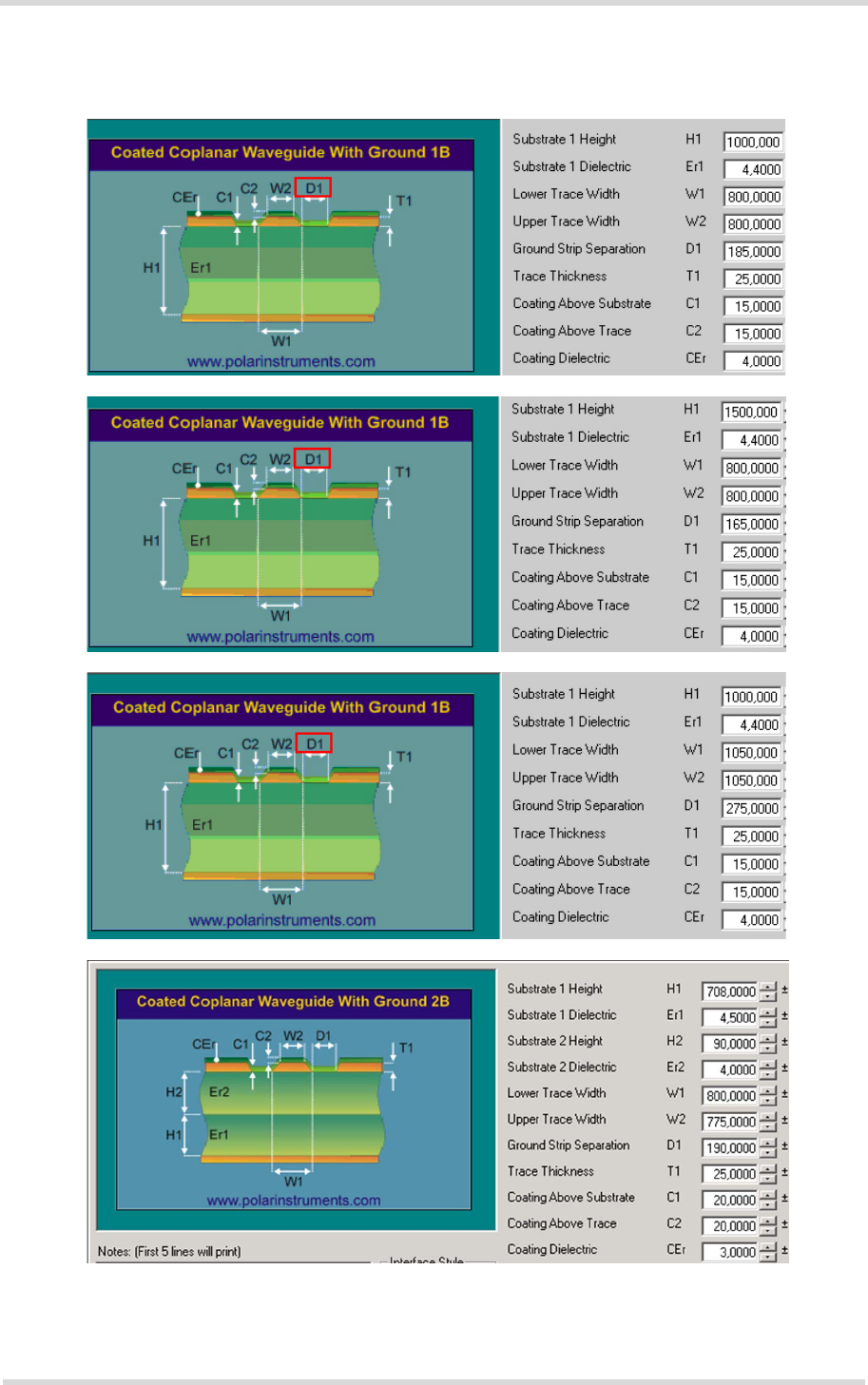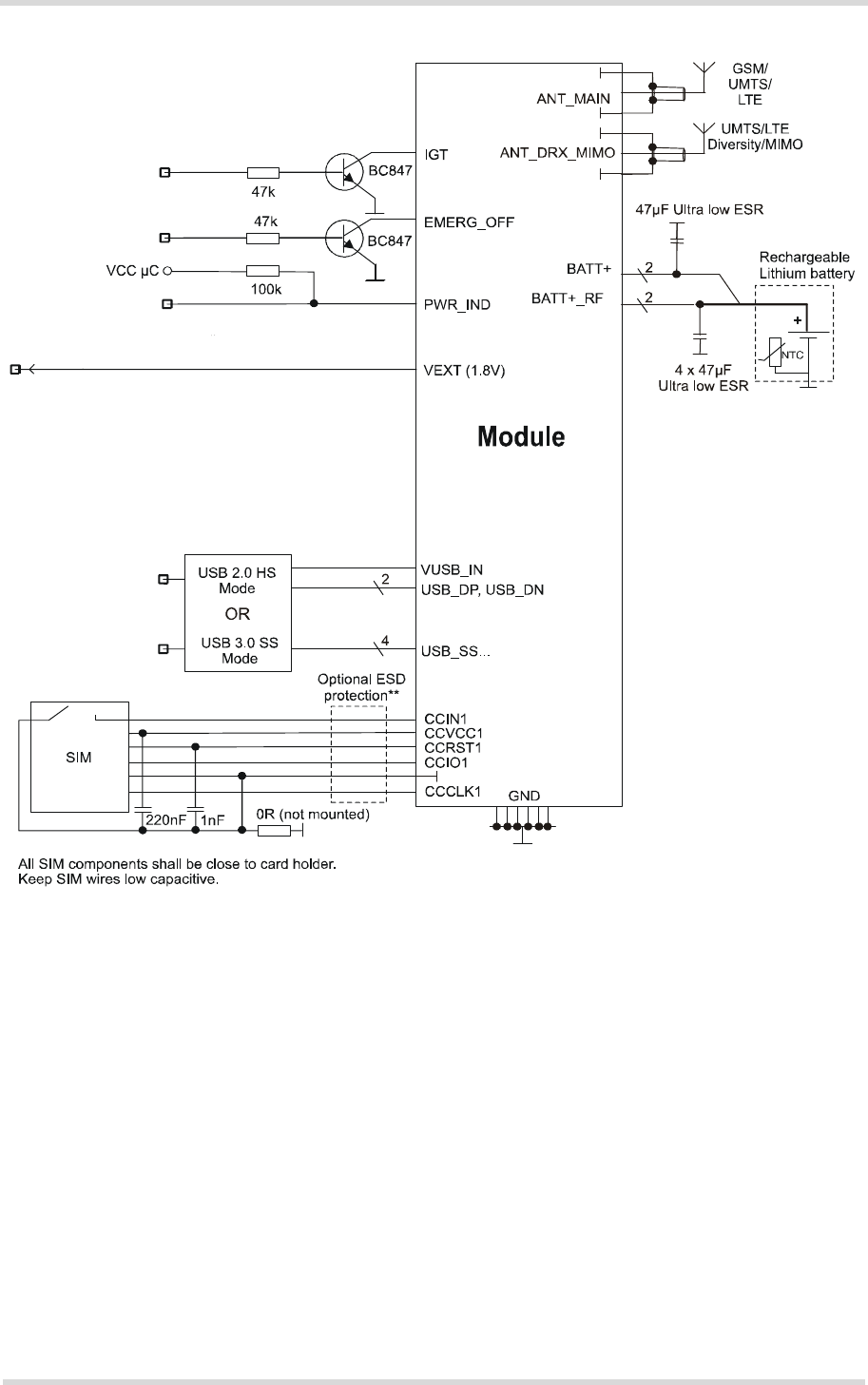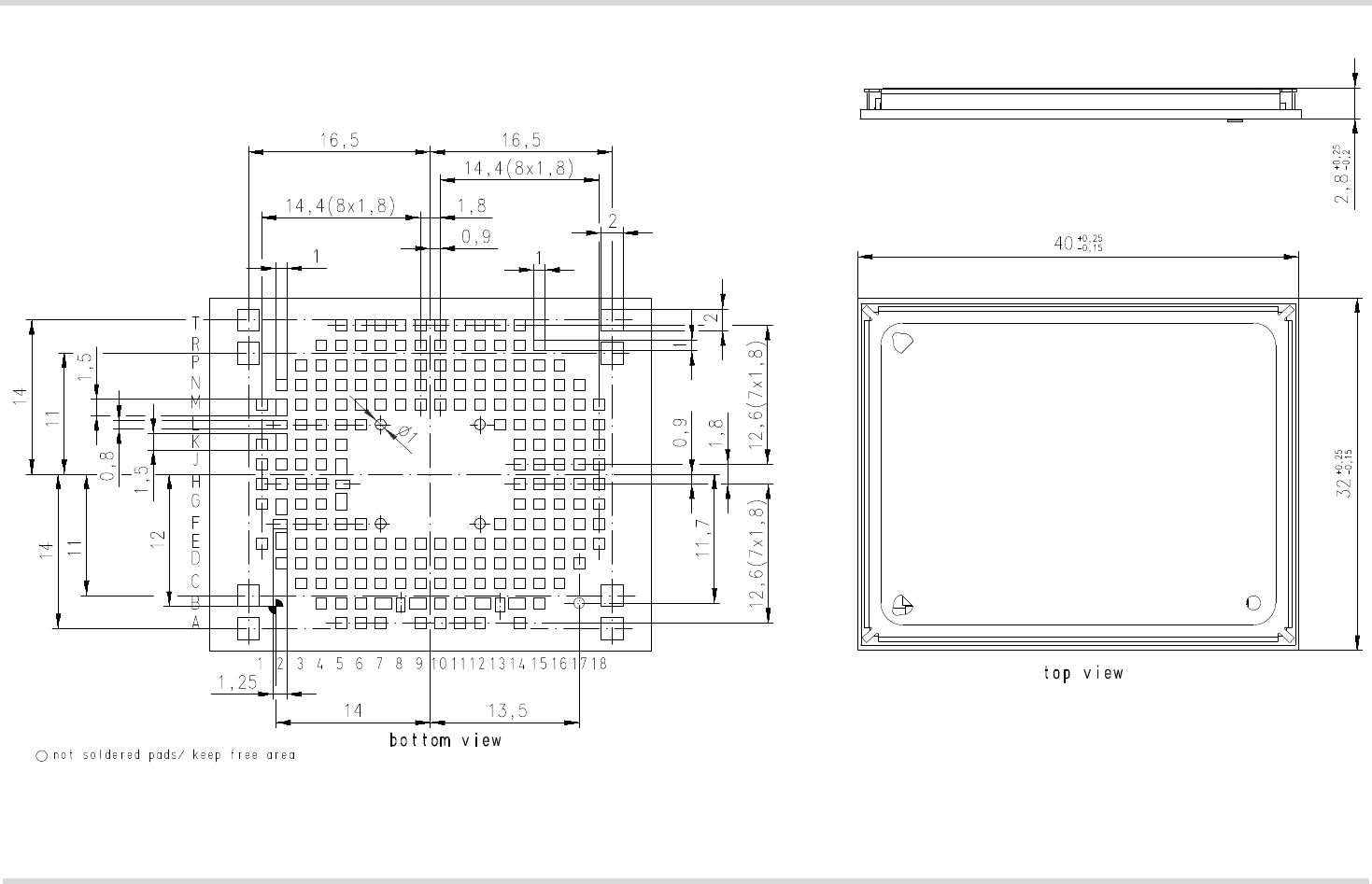THALES DIS AlS Deutschland PLAS9-X Cinterion Module PLAS9-X User Manual plas9 x hid
Gemalto M2M GmbH Cinterion Module PLAS9-X plas9 x hid
user manual
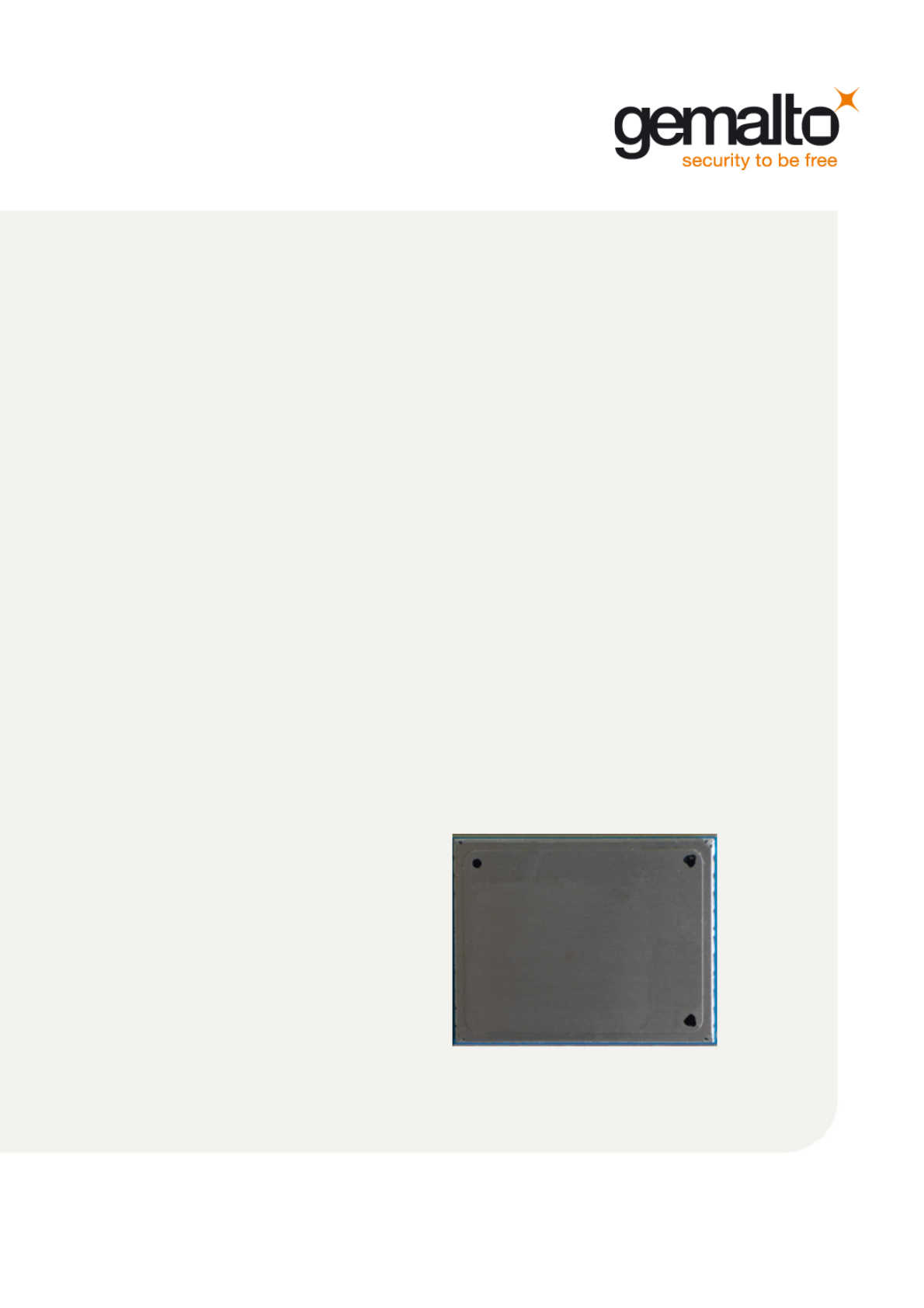
M2M.GEMALTO.COM
Cinterion® PLAS9-X
Hardware Interface Overview
Version: 00.044
DocId: PLAS9-X_HIO_v00.044

GENERAL NOTE
THE USE OF THE PRODUCT INCLUDING THE SOFTWARE AND DOCUMENTATION (THE "PROD-
UCT") IS SUBJECT TO THE RELEASE NOTE PROVIDED TOGETHER WITH PRODUCT. IN ANY
EVENT THE PROVISIONS OF THE RELEASE NOTE SHALL PREVAIL. THIS DOCUMENT CONTAINS
INFORMATION ON GEMALTO M2M PRODUCTS. THE SPECIFICATIONS IN THIS DOCUMENT ARE
SUBJECT TO CHANGE AT GEMALTO M2M'S DISCRETION. GEMALTO M2M GMBH GRANTS A NON-
EXCLUSIVE RIGHT TO USE THE PRODUCT. THE RECIPIENT SHALL NOT TRANSFER, COPY,
MODIFY, TRANSLATE, REVERSE ENGINEER, CREATE DERIVATIVE WORKS; DISASSEMBLE OR
DECOMPILE THE PRODUCT OR OTHERWISE USE THE PRODUCT EXCEPT AS SPECIFICALLY
AUTHORIZED. THE PRODUCT AND THIS DOCUMENT ARE PROVIDED ON AN "AS IS" BASIS ONLY
AND MAY CONTAIN DEFICIENCIES OR INADEQUACIES. TO THE MAXIMUM EXTENT PERMITTED
BY APPLICABLE LAW, GEMALTO M2M GMBH DISCLAIMS ALL WARRANTIES AND LIABILITIES.
THE RECIPIENT UNDERTAKES FOR AN UNLIMITED PERIOD OF TIME TO OBSERVE SECRECY
REGARDING ANY INFORMATION AND DATA PROVIDED TO HIM IN THE CONTEXT OF THE DELIV-
ERY OF THE PRODUCT. THIS GENERAL NOTE SHALL BE GOVERNED AND CONSTRUED
ACCORDING TO GERMAN LAW.
Copyright
Transmittal, reproduction, dissemination and/or editing of this document as well as utilization of its con-
tents and communication thereof to others without express authorization are prohibited. Offenders will be
held liable for payment of damages. All rights created by patent grant or registration of a utility model or
design patent are reserved.
Copyright © 2017, Gemalto M2M GmbH, a Gemalto Company
Trademark Notice
Gemalto, the Gemalto logo, are trademarks and service marks of Gemalto and are registered in certain
countries. Microsoft and Windows are either registered trademarks or trademarks of Microsoft Corpora-
tion in the United States and/or other countries. All other registered trademarks or trademarks mentioned
in this document are property of their respective owners.
PLAS9-X_HIO_v00.044 2017-09-19
Confidential / Preliminary
Cinterion® PLAS9-X Hardware Interface Overview
2
Page 2 of 39
Document Name: Cinterion® PLAS9-X Hardware Interface Overview
Version: 00.044
Date: 2017-09-19
DocId: PLAS9-X_HIO_v00.044
Status Confidential / Preliminary

Cinterion® PLAS9-X Hardware Interface Overview
Contents
39
PLAS9-X_HIO_v00.044 2017-09-19
Confidential / Preliminary
Page 3 of 39
Contents
1 Introduction ................................................................................................................. 6
1.1 Key Features at a Glance .................................................................................. 6
1.2 PLAS9-X System Overview ............................................................................... 9
2 Interface Characteristics .......................................................................................... 10
2.1 Application Interface ........................................................................................ 10
2.1.1 USB Interface...................................................................................... 10
2.1.2 UICC/SIM/USIM Interface................................................................... 11
2.1.3 Analog-to-Digital Converter (ADC)...................................................... 13
2.1.4 GPIO Interface.................................................................................... 13
2.1.5 Control Signals.................................................................................... 14
2.1.5.1 PWR_IND Signal................................................................. 14
2.1.5.2 Behavior of the RING0 Line ................................................ 14
2.1.5.3 Remote Wakeup.................................................................. 14
2.1.5.4 Low Current Indicator.......................................................... 14
2.2 GSM/UMTS/LTE Antenna Interface................................................................. 15
2.2.1 Antenna Installation ............................................................................ 16
2.2.2 RF Line Routing Design...................................................................... 17
2.2.2.1 Line Arrangement Instructions ............................................ 17
2.2.2.2 Routing Examples............................................................... 19
2.3 Sample Application .......................................................................................... 21
3 Operating Characteristics ........................................................................................ 23
3.1 Operating Modes ............................................................................................. 23
3.2 Power Supply................................................................................................... 24
4 Mechanical Dimensions ........................................................................................... 25
4.1 Mechanical Dimensions of PLAS9-X ............................................................... 25
5 Regulatory and Type Approval Information ........................................................... 27
5.1 Directives and Standards................................................................................. 27
5.2 SAR requirements specific to portable mobiles ............................................... 29
5.3 Reference Equipment for Type Approval......................................................... 30
5.4 Compliance with FCC and IC Rules and Regulations ..................................... 31
6 Document Information.............................................................................................. 33
6.1 Revision History............................................................................................... 33
6.2 Related Documents ......................................................................................... 33
6.3 Terms and Abbreviations................................................................................. 33
6.4 Safety Precaution Notes .................................................................................. 36
7 Appendix.................................................................................................................... 37
7.1 List of Parts and Accessories........................................................................... 37

Cinterion® PLAS9-X Hardware Interface Overview
Tables
39
PLAS9-X_HIO_v00.044 2017-09-19
Confidential / Preliminary
Page 4 of 39
Tables
Table 1: Signals of the SIM interface (SMT application interface) ............................... 11
Table 2: Return loss in the active band........................................................................ 15
Table 3: Overview of operating modes ........................................................................ 23
Table 4: Directives ....................................................................................................... 27
Table 5: Standards of North American type approval .................................................. 27
Table 6: Requirements of quality ................................................................................. 27
Table 7: Standards of the Ministry of Information Industry of the
People’s Republic of China............................................................................ 28
Table 8: Toxic or hazardous substances or elements with defined concentration
limits............................................................................................................... 28
Table 9: Antenna gain limits for FCC and IC (TBD.).................................................... 31
Table 10: List of parts and accessories.......................................................................... 37
Table 11: Molex sales contacts (subject to change) ...................................................... 38
Table 12: Hirose sales contacts (subject to change) ..................................................... 38

Cinterion® PLAS9-X Hardware Interface Overview
Figures
39
PLAS9-X_HIO_v00.044 2017-09-19
Confidential / Preliminary
Page 5 of 39
Figures
Figure 1: PLAS9-X system overview............................................................................... 9
Figure 2: USB circuit ..................................................................................................... 10
Figure 3: First UICC/SIM/USIM interface ...................................................................... 12
Figure 4: Second UICC/SIM/USIM interface................................................................. 12
Figure 5: Embedded Stripline line arrangement............................................................ 17
Figure 6: Micro-Stripline line arrangement samples...................................................... 18
Figure 7: Routing to application‘s RF connector ........................................................... 19
Figure 8: Routing to PLAS9-X evaluation module‘s RF connector................................ 20
Figure 9: PLAS9-X sample application.......................................................................... 22
Figure 10: Decoupling capacitor(s) for BATT+................................................................ 24
Figure 11: PLAS9-X – top and bottom view .................................................................... 25
Figure 12: Dimensions of PLAS9-X (all dimensions in mm)............................................ 26
Figure 13: Reference equipment for type approval......................................................... 30

Cinterion® PLAS9-X Hardware Interface Overview
1 Introduction
9
PLAS9-X_HIO_v00.044 2017-09-19
Confidential / Preliminary
Page 6 of 39
1 Introduction
This document1 describes the hardware of the Cinterion® PLAS9-X module. It helps you quickly
retrieve interface specifications, electrical and mechanical details and information on the re-
quirements to be considered for integrating further components.
1.1 Key Features at a Glance
1. The document is effective only if listed in the appropriate Release Notes as part of the technical docu-
mentation delivered with your Gemalto M2M product.
Feature Implementation
General
Frequency bands GSM/GPRS/EDGE: Quad band, 850/900/1800/1900MHz
UMTS/HSPA+: Triple band, 850 (BdV), 1700 (BdIV), 1900 (BdII)
LTE (FDD): Six band, 700 (Bd12 <MFBI Bd17>, Bd13, Bd29 <supplemen-
tary downlink>), 850 (Bd5), 1700 (Bd4), 1900 (Bd2)
GSM class Small MS
Output power
(according to Release 99) Class 4 (+33dBm ±2dB) for EGSM850
Class 4 (+33dBm ±2dB) for EGSM900
Class 1 (+30dBm ±2dB) for GSM1800
Class 1 (+30dBm ±2dB) for GSM1900
Class E2 (+27dBm ± 3dB) for GSM 850 8-PSK
Class E2 (+27dBm ± 3dB) for GSM 900 8-PSK
Class E2 (+26dBm +3 /-4dB) for GSM 1800 8-PSK
Class E2 (+26dBm +3 /-4dB) for GSM 1900 8-PSK
Class 3 (+24dBm +1/-3dB) for UMTS 1900,WCDMA FDD BdII
Class 3 (+24dBm +1/-3dB) for UMTS 1700, WCDMA FDD BdIV
Class 3 (+24dBm +1/-3dB) for UMTS 850, WCDMA FDD BdV
Output power
(according to Release 8) LTE (FDD):
Class 3 (+23dBm +-2dB) for LTE 700, LTE FDD Bd12 <MFBI Bd17>
Class 3 (+23dBm +-2dB) for LTE 700, LTE FDD Bd13
Class 3 (+23dBm +-2dB) for LTE 850, LTE FDD Bd5
Class 3 (+23dBm +-2dB) for LTE 1700, LTE FDD Bd4
Class 3 (+23dBm +-2dB) for LTE1900, LTE FDD Bd2
Power supply 3.3V < VBATT+ < 4.2V
Operating temperature
(board temperature) Normal operation: -30°C to +85°C
Extended operation: -40°C to +95°C
Physical Dimensions: 40mm x 32mm x 2.8mm
Weight: approx. 6.5g
RoHS All hardware components fully compliant with EU RoHS Directive

Cinterion® PLAS9-X Hardware Interface Overview
1.1 Key Features at a Glance
9
PLAS9-X_HIO_v00.044 2017-09-19
Confidential / Preliminary
Page 7 of 39
LTE features
3GPP Release 10 Downlink carrier aggregation (CA) to increase bandwidth, and thereby
increase bitrate:
• Maximum aggregated bandwidth: 40MHz
• Maximum number of component carriers: 2
• Inter-band FDD, non-contiguous
• Intra-band FDD, contiguous, non-contiguous
• Supported inter-band CA configurations:
CA_2A-5A (with bandwidth combination set 0),
CA_2A-12A (with bandwidth combination sets 0 and 1),
CA_2A-29A (with bandwidth combination sets 0, 1 and 2),
CA_4A-5A (with bandwidth combination sets 0 and 1),
CA_4A-12A (with bandwidth combination sets 0, 1, 2, 3 and 4),
CA_4A-29A (with bandwidth combination sets 0, 1 and 2)
• Supported intra-band CA configurations:
CA_4A-4A (with bandwidth combination set 0)
CAT 6 supported
DL 300Mbps, UL 50Mbps
2x2 MIMO in DL direction
HSPA features
3GPP Release 9 UE CAT. 14, 24
DC-HSPA+ – DL 42Mbps
HSUPA – UL 5.76Mbps
Compressed mode (CM) supported according to 3GPP TS25.212
UMTS features
3GPP Release 9 PS data rate – 384 kbps DL / 384 kbps UL
GSM / GPRS / EGPRS features
Data transfer GPRS:
• Multislot Class 12
• Mobile Station Class B
• Coding Scheme 1 – 4
EGPRS:
• Multislot Class 12
• EDGE E2 power class for 8 PSK
• Downlink coding schemes – CS 1-4, MCS 1-9
• Uplink coding schemes – CS 1-4, MCS 1-9
• SRB loopback and test mode B
• 8-bit, 11-bit RACH
• 1 phase/2 phase access procedures
• Link adaptation and IR
• NACC, extended UL TBF
• Mobile Station Class B
SMS Point-to-point MT and MO, Cell broadcast,
Text and PDU mode
Software
AT commands Hayes, 3GPP TS 27.007 and 27.005, and proprietary Gemalto M2M com-
mands
Feature Implementation

Cinterion® PLAS9-X Hardware Interface Overview
1.1 Key Features at a Glance
9
PLAS9-X_HIO_v00.044 2017-09-19
Confidential / Preliminary
Page 8 of 39
Firmware update Generic update from host application over USB 2.0 High Speed device
interface
Interfaces
Module interface Surface mount device with solderable connection pads (SMT application
interface).
Land grid array (LGA) technology ensures high solder joint reliability and
provides the possibility to use an optional module mounting socket.
For more information on how to integrate SMT modules see also [3]. This
application note comprises chapters on module mounting and application
layout issues as well as on additional SMT application development equip-
ment.
Antenna 50. GSM/UMTS/LTE main antenna, UMTS/LTE Diversity/MIMO antenna
USB USB 2.0 High Speed (480Mbit/s) device interface or
USB 3.0 Super Speed (5Gbit/s) device interface
UICC interface 2 UICC interfaces (switchable)
Supported chip cards: UICC/SIM/USIM 3V, 1.8V
RING0 Signal line to indicate URCs.
Power on/off, Reset
Power on/off Switch-on by hardware signal IGT
Switch-off by AT command (AT^SMSO) or IGT (option)
Automatic switch-off in case of critical temperature or voltage conditions
Reset Orderly shutdown and reset by AT command
Emergency-off Emergency-off by hardware signal EMERG_OFF
Special Features
Antenna SAIC (Single Antenna Interference Cancellation) / DARP (Downlink
Advanced Receiver Performance)
Rx Diversity (receiver type 3i - 64-QAM) / MIMO
GPIO 10 I/O pins of the application interface programmable as GPIO.
Programming is done via AT commands.
ADC inputs Analog-to-Digital Converter with two unbalanced analog inputs for (exter-
nal) antenna diagnosis
Evaluation kit
Evaluation module PLAS9-X module soldered onto a dedicated PCB that can be connected
to the ALAS6A-DSB75 adapter in order to be mounted onto the DSB75.
ALAS6A-DSB75 adapter A special adapter required to connect the PLAS9-X evaluation module to
the DSB75.
DSB75 DSB75 Development Support Board designed to test and type approve
Gemalto M2M modules and provide a sample configuration for application
engineering.
Feature Implementation
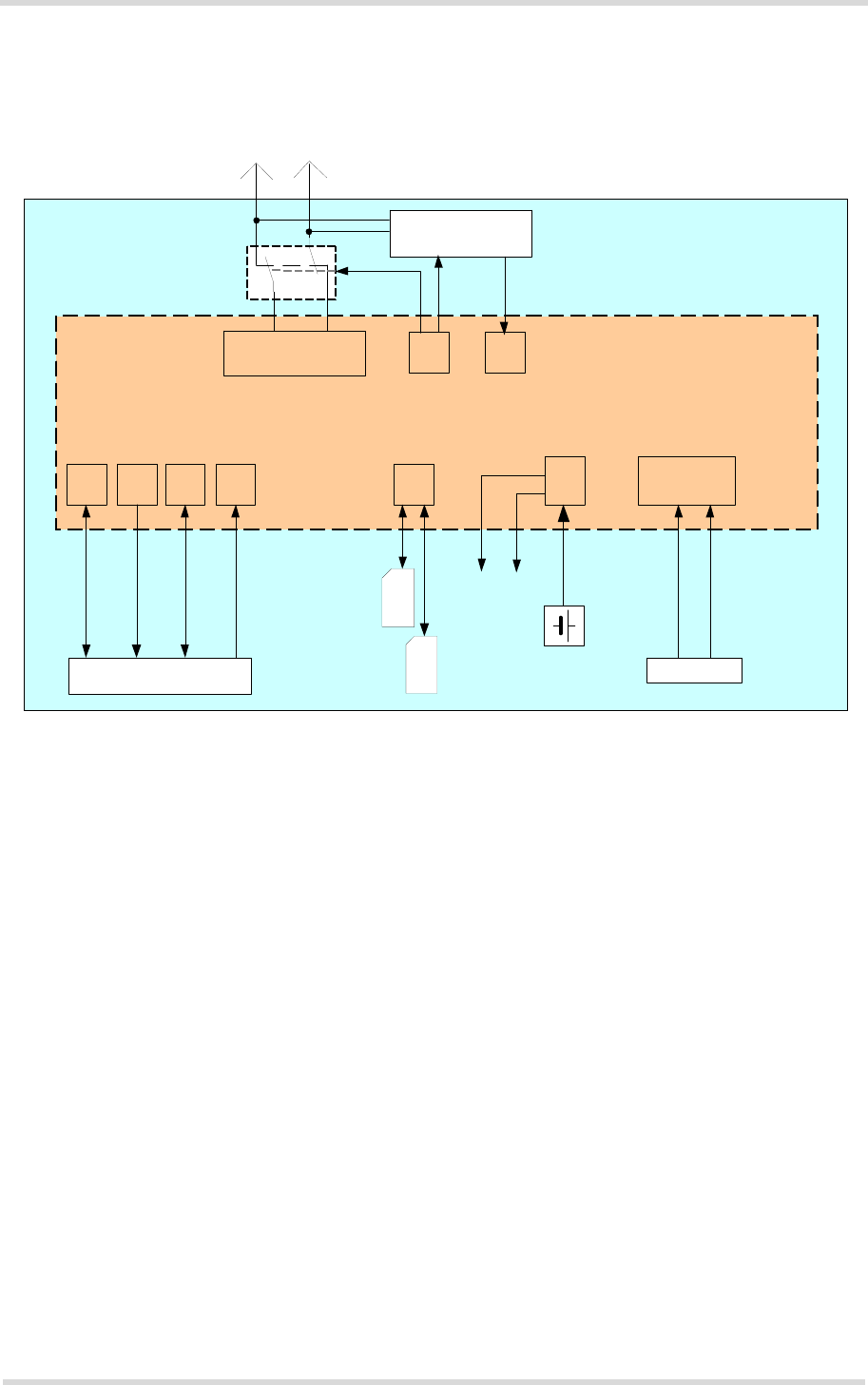
Cinterion® PLAS9-X Hardware Interface Overview
1.2 PLAS9-X System Overview
9
PLAS9-X_HIO_v00.044 2017-09-19
Confidential / Preliminary
Page 9 of 39
1.2 PLAS9-X System Overview
Figure 1: PLAS9-X system overview
GPIO ADC UICC Power
supply IGT,
Emergency Off
SIM
card
Host application On/Off
Module
Application
Power indication
(PWR_IND)
GSM/UMTS/LTE
Power for application
(VEXT)
USB
GSM/UMTS/LTE
Antenna diversity
12
Antenna
diagnostic
Antenna
switch
2x
GPIO
2x
ADC
SIM
card
RING0
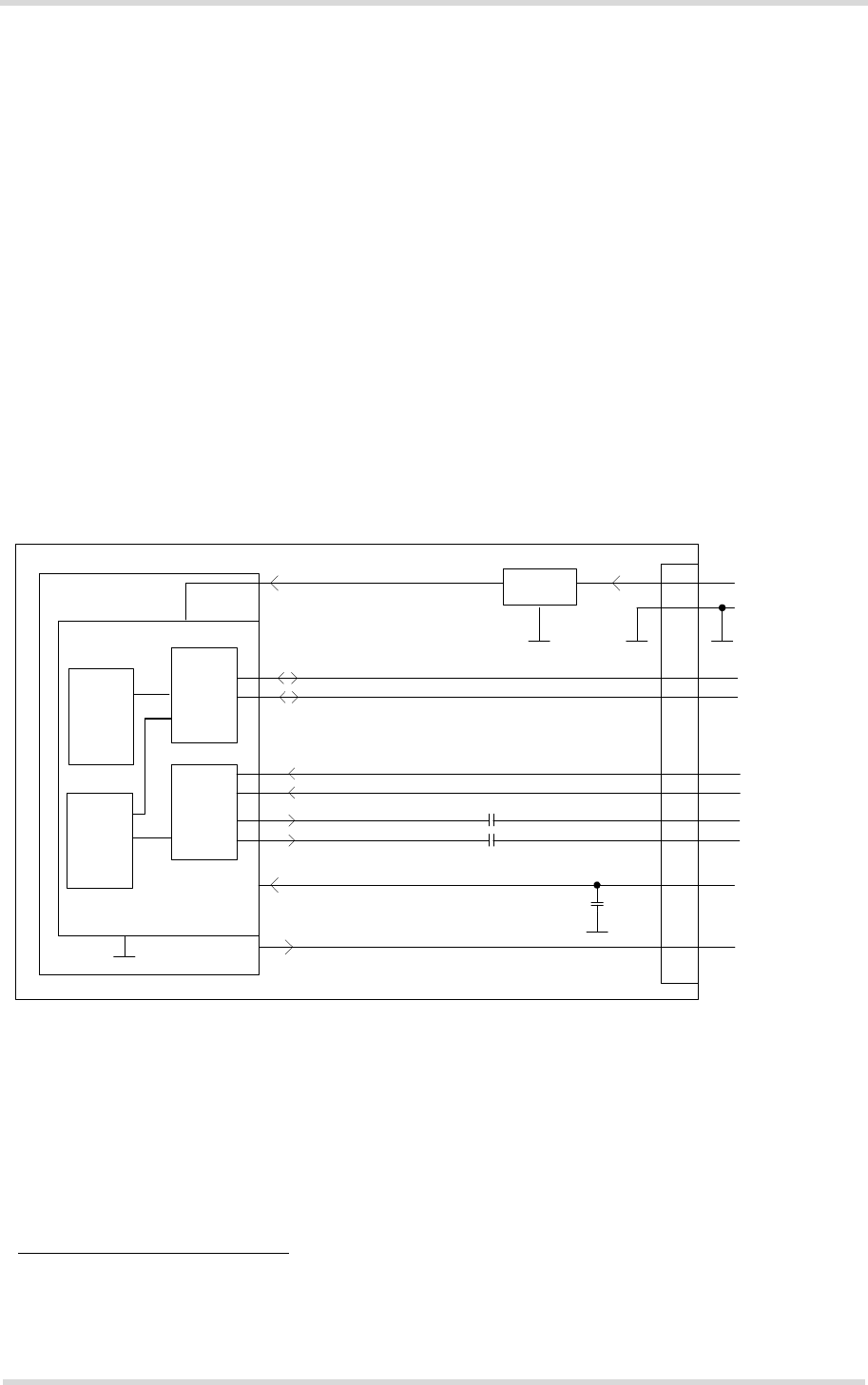
Cinterion® PLAS9-X Hardware Interface Overview
2 Interface Characteristics
22
PLAS9-X_HIO_v00.044 2017-09-19
Confidential / Preliminary
Page 10 of 39
2 Interface Characteristics
PLAS9-X is equipped with an SMT application interface that connects to the external applica-
tion. The SMT application interface incorporates the various application interfaces as well as
the RF antenna interface.
2.1 Application Interface
2.1.1 USB Interface
PLAS9-X supports a USB 3.0 Super Speed (5Gbps) device interface, and alternatively a
USB 2.0 device interface that is High Speed and Full Speed compatible. The USB interface is
primarily intended for use as command and data interface, and for downloading firmware1.
The USB host is responsible for supplying the VUSB_IN line. This line is for voltage detection
only. The USB part (driver and transceiver) is supplied by means of BATT+. This is because
PLAS9-X is designed as a self-powered device compliant with the “Universal Serial Bus Spec-
ification Revision 3.0”2.
Figure 2: USB circuit
To properly connect the module's USB interface to the external application, a USB 3.0 or 2.0
compatible connector and cable or hardware design is required. Furthermore, the USB modem
driver distributed with PLAS9-X needs to be installed.
1. Note: For firmware download, the module enumerates new as a USB 2.0 device. Also, it is not possible
to use the USB 2.0 High Speed device mode and the USB 3.0 Super speed device mode simultaneously.
2. The specification is ready for download on http://www.usb.org/developers/docs/
VREG (3V075) BATT+
USB_DP3)
lin. reg.
GND
Module
Detection only VUSB_IN2)
USB part1)
1) All serial (including RS) and pull-up resistors for data lines are implemented.
USB_DN3)
3) If the USB interface is operated in High Speed mode (480MHz), it is recommended to take special care routing the data
lines USB_DP and USB_DN. Application layout should in this case implement a differential impedance of 90 ohms for
proper signal integrity.
VBUS
1µF
2) Since VUSB_IN is used for detection only it is recommended not to add any further blocking capacitors on
the VUSB_IN line.
Host wakeup RING0
USB_SSRX_N
USB_SSRX_P
USB_SSTX_N
USB_SSTX_P
USB_SS
_PHY
USB_HS
_PHY
USB 2.0
Controller
USB 3.0
Controller
2.0
2.0
3.0
100nF
100nF
SMT

Cinterion® PLAS9-X Hardware Interface Overview
2.1 Application Interface
22
PLAS9-X_HIO_v00.044 2017-09-19
Confidential / Preliminary
Page 11 of 39
2.1.2 UICC/SIM/USIM Interface
PLAS9-X has two UICC/SIM/USIM interfaces compatible with the 3GPP 31.102 and ETSI 102
221. These are wired to the host interface in order to be connected to an external SIM card
holder. Five pads on the SMT application interface are reserved for each of the two SIM inter-
faces.
The UICC/SIM/USIM interface supports 3V and 1.8V SIM cards.
The CCINx signal serves to detect whether a tray (with SIM card) is present in the card holder.
Using the CCINx signal is mandatory for compliance with the GSM 11.11 recommendation if
the mechanical design of the host application allows the user to remove the SIM card during
operation. To take advantage of this feature, an appropriate SIM card detect switch is required
on the card holder. For example, this is true for the model supplied by Molex, which has been
tested to operate with PLAS9-X and is part of the Gemalto M2M reference equipment submit-
ted for type approval. See Chapter 7 for Molex ordering numbers.
Note: No guarantee can be given, nor any liability accepted, if loss of data is encountered after
removing the SIM card during operation. Also, no guarantee can be given for properly initializ-
ing any SIM card that the user inserts after having removed the SIM card during operation. In
this case, the application must restart PLAS9-X.
By default, only the 1st SIM interface is available and can be used. Using the AT command
AT^SCFG=”SIM/CS” it is possible to switch between the two SIM interfaces. Command set-
tings are non-volatile - for details see [1].
Table 1: Signals of the SIM interface (SMT application interface)
Signal Description
GND Ground connection for SIM interfaces. Optionally a separate SIM ground line using e.g.,
pad P12, may be used to improve EMC.
CCCLK1
CCCLK2 Chipcard clock lines for 1st and 2nd SIM interface.
CCVCC1
CCVCC2 SIM supply voltage lines for 1st and 2nd SIM interface.
CCIO1
CCIO2 Serial data lines for 1st and 2nd SIM interface, input and output.
CCRST1
CCRST2 Chipcard reset lines for 1st and 2nd SIM interface.
CCIN1
CCIN2 Input on the baseband processor for detecting a SIM card tray in the holder. If the SIM is
removed during operation the SIM interface is shut down immediately to prevent destruc-
tion of the SIM. The CCINx signal is active low.
The CCINx signal is mandatory for applications that allow the user to remove the SIM card
during operation.
The CCINx signal is solely intended for use with a SIM card. It must not be used for any
other purposes. Failure to comply with this requirement may invalidate the type approval of
PLAS9-X.
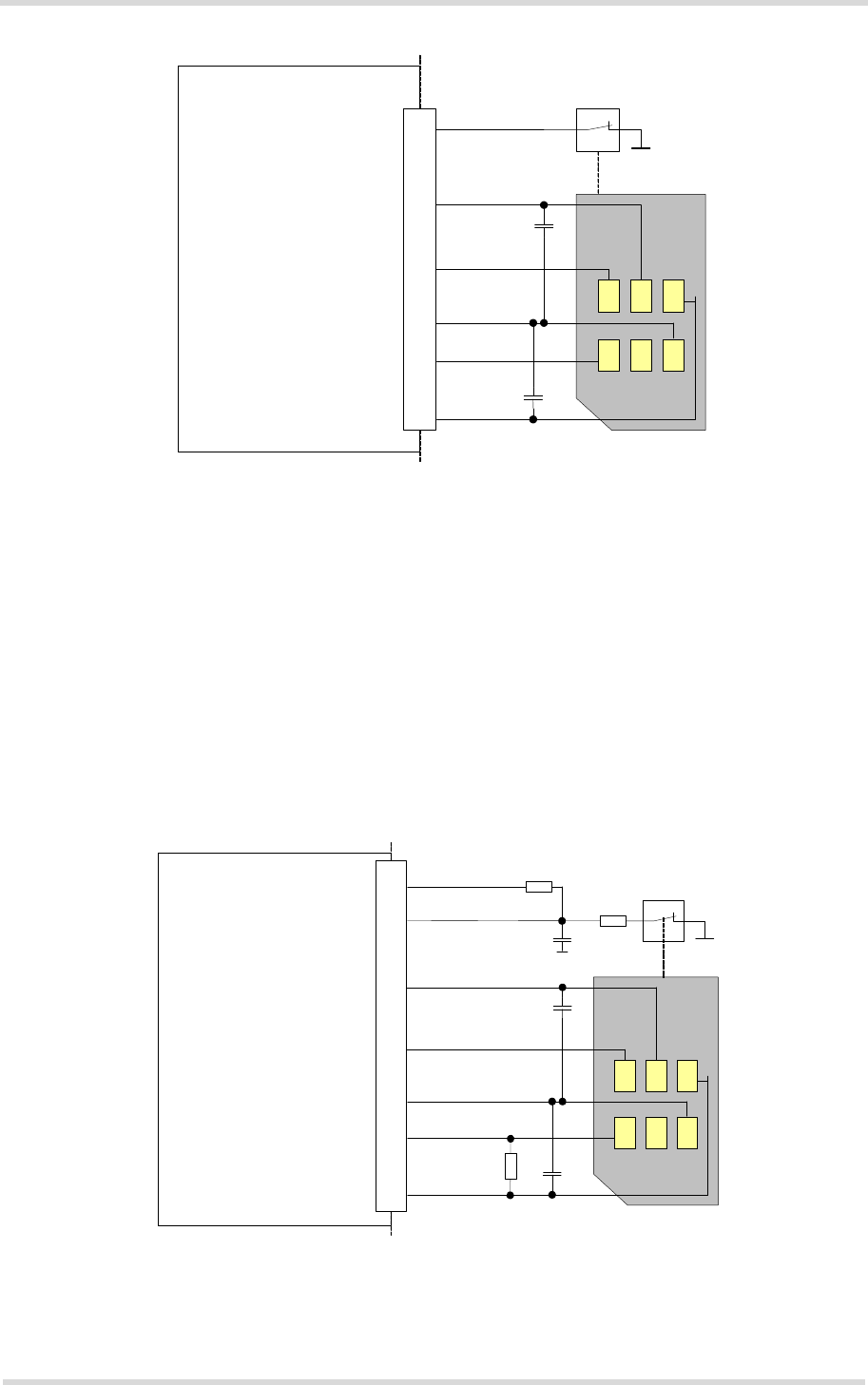
Cinterion® PLAS9-X Hardware Interface Overview
2.1 Application Interface
22
PLAS9-X_HIO_v00.044 2017-09-19
Confidential / Preliminary
Page 12 of 39
Figure 3: First UICC/SIM/USIM interface
The total cable length between the SMT application interface pads on PLAS9-X and the pads
of the external SIM card holder must not exceed 100mm in order to meet the specifications of
3GPP TS 51.010-1 and to satisfy the requirements of EMC compliance.
To avoid possible cross-talk from the CCCLKx signal to the CCIOx signal be careful that both
lines are not placed closely next to each other. A useful approach is using the GND line to
shield the CCIOx line from the CCCLKx line.
Note: Figure 3 shows how to connect a SIM card holder to the first SIM interface. With the sec-
ond SIM interface some internally integrated components on the SIM circuit will have to be ex-
ternally integrated as shown for the second SIM interface in Figure 4. The external components
at CCIN2 should be populated as close as possible to the signal‘s SMT pad
Figure 4: Second UICC/SIM/USIM interface
Module
open: Card removed
closed: Card inserted
CCRST1
CCVCC1
CCIO1
CCCLK1
CCIN1
SIM /
UICC
1n
220n
SMT application interface
GND
Module
Open: Card removed
Closed: Card inserted
CCRST2
CCVCC2
CCIO2
CCCLK2
CCIN2
SIM /
UICC
1nF
220nF
SMT application interface
GND
VEXT
100pF
22k
2k2
10k

Cinterion® PLAS9-X Hardware Interface Overview
2.1 Application Interface
22
PLAS9-X_HIO_v00.044 2017-09-19
Confidential / Preliminary
Page 13 of 39
2.1.3 Analog-to-Digital Converter (ADC)
PLAS9-X provides two unbalanced ADC input lines: ADC1_IN and ADC2_IN. They can be
used to measure two independent, externally connected DC voltages in the range of 0.05V to
VBATT+.
2.1.4 GPIO Interface
PLAS9-X has 10 GPIOs for external hardware devices. Each GPIO can be configured for use
as input or output. All settings are AT command controlled.
GPIO1...GPIO10 may be configured as low current indicator signal (see Section 2.1.5.4), or
may be set as remote host wakeup lines (see Section 2.1.5.3).

Cinterion® PLAS9-X Hardware Interface Overview
2.1 Application Interface
22
PLAS9-X_HIO_v00.044 2017-09-19
Confidential / Preliminary
Page 14 of 39
2.1.5 Control Signals
2.1.5.1 PWR_IND Signal
PWR_IND notifies the on/off state of the module. High state of PWR_IND indicates that the
module is switched off. The state of PWR_IND immediately changes to low when IGT is pulled
low. For state detection an external pull-up resistor is required.
2.1.5.2 Behavior of the RING0 Line
The RING0 line serves to indicate URCs (Unsolicited Result Code).
The RING0 line behavior and usage can be configured by AT command. For details see [1]:
AT^SCFG.
2.1.5.3 Remote Wakeup
If no call, data or message transfer is in progress, the external host application may shut down
its own module interfaces or other components in order to save power. If a call, data, or other
request (URC) arrives, the external application can be notified of this event and be woken up
again by a state transition of a configurable remote wakeup line. Available as remote wakeup
lines are all GPIO signals as well as the RING0 line. Please refer to [1]: AT^SCFG: "Re-
moteWakeUp/..." for details on how to configure these lines for defined wakeup events on
specified device interfaces.
2.1.5.4 Low Current Indicator
A low current indication is optionally available over a GPIO line. By default, low current indica-
tion is disabled and the GPIO pads can be configured and employed as usual.
For a GPIO pad to work as a low current indicator the feature has to be enabled by AT com-
mand (see [1]: AT^SCFG: MEopMode/PowerMgmt/LCI). By default, the GPIO6 pad is config-
ured as LCI_IND signal.
If enabled, the GPIOx/LCI_IND signal is high when the module is sleeping.

Cinterion® PLAS9-X Hardware Interface Overview
2.2 GSM/UMTS/LTE Antenna Interface
22
PLAS9-X_HIO_v00.044 2017-09-19
Confidential / Preliminary
Page 15 of 39
2.2 GSM/UMTS/LTE Antenna Interface
The PLAS9-X GSM/UMTS/LTE antenna interface comprises a GSM/UMTS/LTE main antenna
as well as a UMTS/LTE Rx diversity/MIMO antenna to improve signal reliability and quality1.
The interface has an impedance of 50. PLAS9-X is capable of sustaining a total mismatch at
the antenna interface without any damage, even when transmitting at maximum RF power.
The external antennas must be matched properly to achieve best performance regarding radi-
ated power, modulation accuracy and harmonic suppression. Matching networks are not in-
cluded on the PLAS9-X PCB and should be placed in the host application, if the antenna does
not have an impedance of 50.
Regarding the return loss PLAS9-X provides the following values in the active band:
1. By delivery default the UMTS/LTE Rx diversity/MIMO antenna is configured as available for the module
since its usage is mandatory for LTE. Please refer to [1] for details on how to configure antenna settings.
Table 2: Return loss in the active band
State of module Return loss of module Recommended return loss of application
Receive > 8dB > 12dB
Transmit not applicable > 12dB
Idle < 5dB not applicable

Cinterion® PLAS9-X Hardware Interface Overview
2.2 GSM/UMTS/LTE Antenna Interface
22
PLAS9-X_HIO_v00.044 2017-09-19
Confidential / Preliminary
Page 16 of 39
2.2.1 Antenna Installation
The antenna is connected by soldering the antenna pads (ANT_MAIN; ANT_DRX_MIMO) and
their neighboring ground pads directly to the application’s PCB.
The distance between the antenna pads and their neighboring GND pads has been optimized
for best possible impedance. To prevent mismatch, special attention should be paid to these
pads on the application’ PCB.The wiring of the antenna connection, starting from the antenna
pad to the application’s antenna must result in a 50 line impedance. Line width and distance
to the GND plane need to be optimized with regard to the PCB’s layer stack. Related instruc-
tions are given in Section 2.2.2.
To prevent receiver desensitization due to interferences generated by fast transients like high
speed clocks on the external application PCB, it is recommended to realize the antenna con-
nection line using embedded Stripline rather than Micro-Stripline technology. Please see Sec-
tion 2.2.2 for instructions of how to design the antenna connection in order to achieve the
required 50 line impedance.
For type approval purposes (i.e., FCC KDB 996369 related to modular approval requirements),
an external application must connect the RF signal in one of the following ways:
•Via 50
coaxial antenna connector (common connectors are U-FL or SMA) placed as close
as possible to the module's antenna pad.
• By soldering the antenna to the antenna connection line on the application’s PCB (without
the use of any connector) as close as possible to the module’s antenna pad.
• By routing the application PCB’s antenna to the module’s antenna pad in the shortest pos-
sible way.
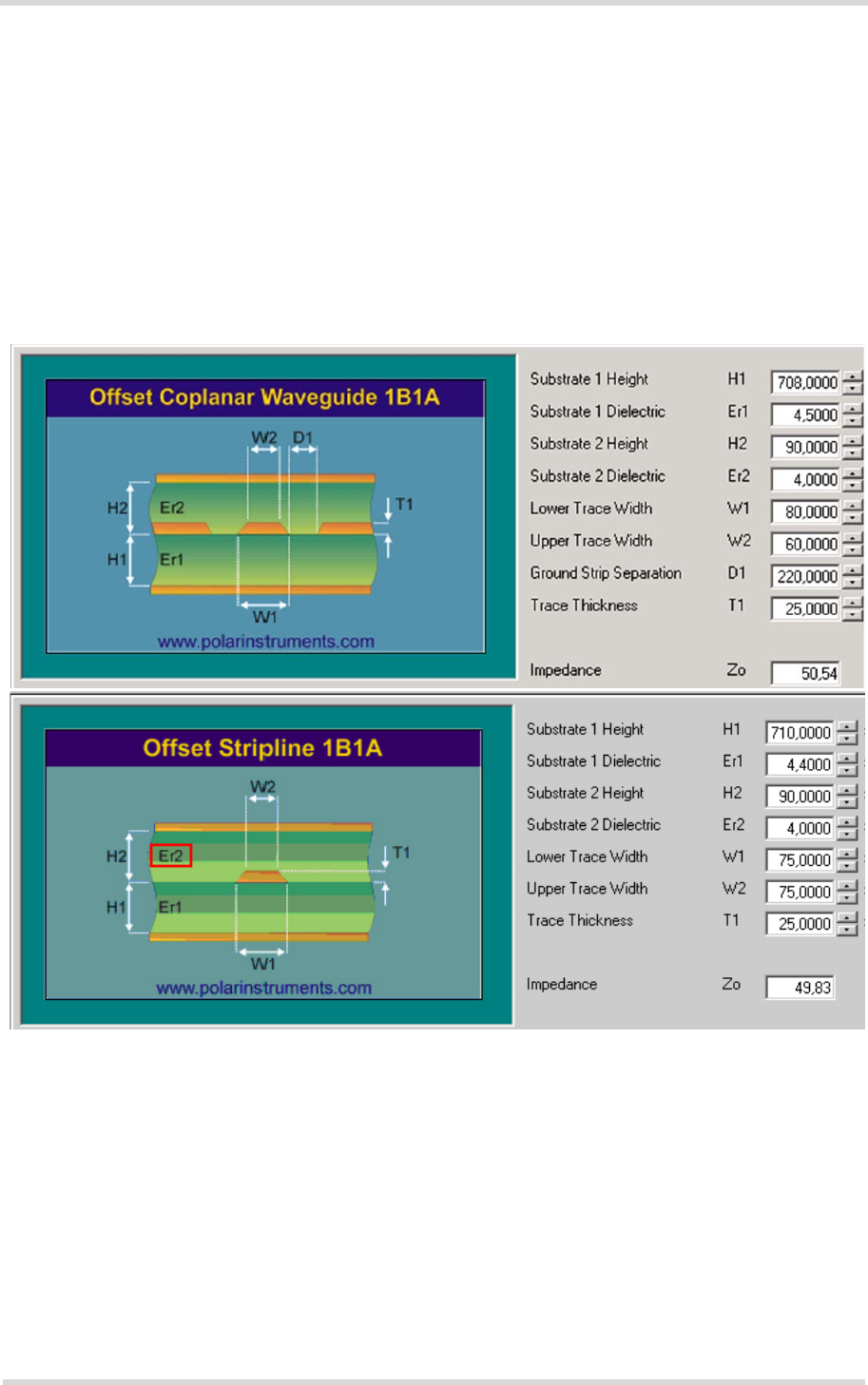
Cinterion® PLAS9-X Hardware Interface Overview
2.2 GSM/UMTS/LTE Antenna Interface
22
PLAS9-X_HIO_v00.044 2017-09-19
Confidential / Preliminary
Page 17 of 39
2.2.2 RF Line Routing Design
2.2.2.1 Line Arrangement Instructions
Several dedicated tools are available to calculate line arrangements for specific applications
and PCB materials - for example from http://www.polarinstruments.com/ (commercial software)
or from http://web.awrcorp.com/Usa/Products/Optional-Products/TX-Line/ (free software).
Embedded Stripline
This below figure shows line arrangement examples for embedded stripline.
Figure 5: Embedded Stripline line arrangement
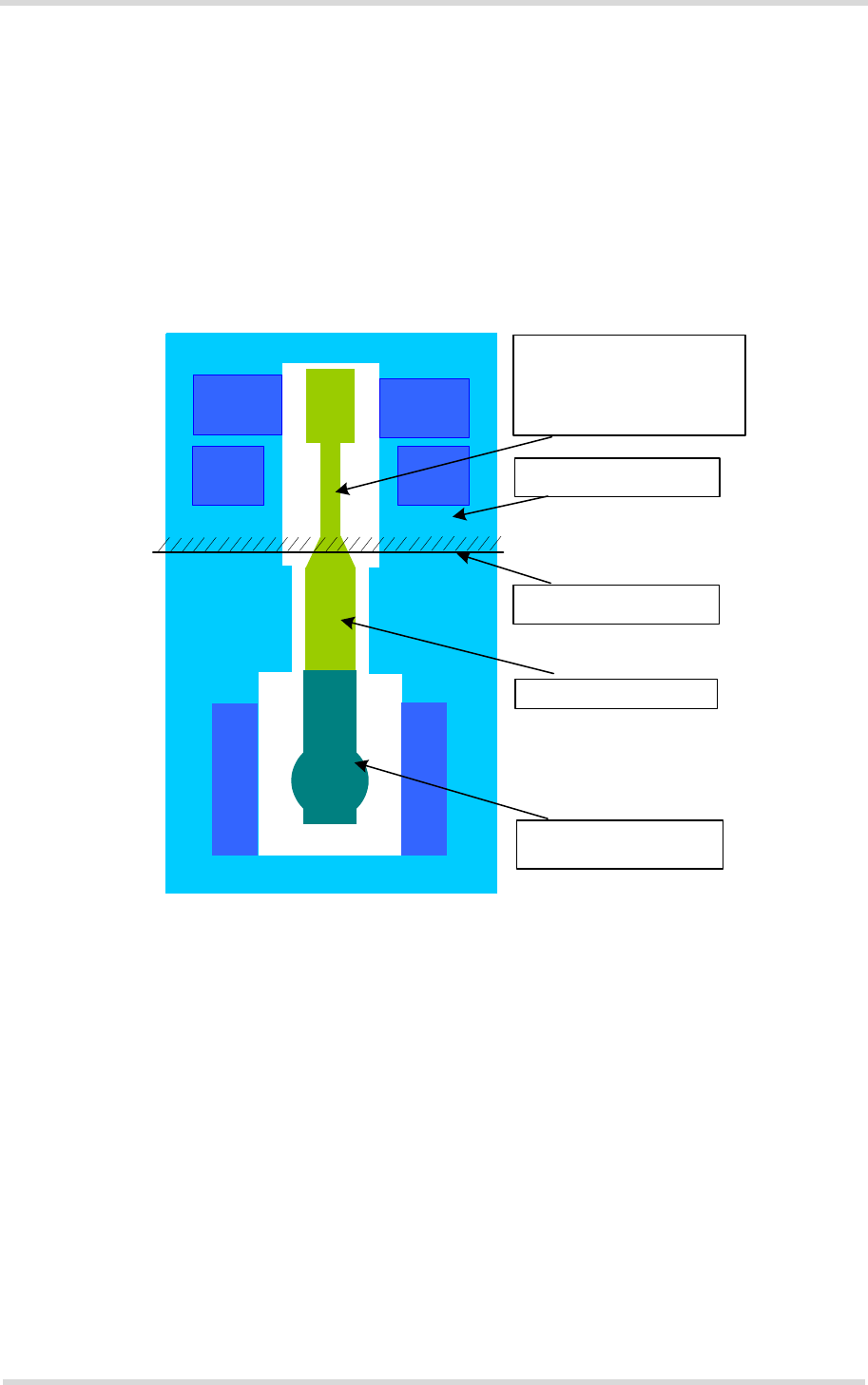
Cinterion® PLAS9-X Hardware Interface Overview
2.2 GSM/UMTS/LTE Antenna Interface
22
PLAS9-X_HIO_v00.044 2017-09-19
Confidential / Preliminary
Page 19 of 39
2.2.2.2 Routing Examples
Interface to RF Connector
Figure 7 shows a sample connection of a module‘s antenna pad at the bottom layer of the mod-
ule PCB with an application PCB‘s coaxial antenna connector. Line impedance depends on line
width, but also on other PCB characteristics like dielectric, height and layer gap. The sample
stripline width of 0.40mm is recommended for an application with a PCB layer stack resembling
the one of the PLAS9-X evaluation board. For different layer stacks the stripline width will have
to follow stripline routing rules, avoiding 90 degree corners and using the shortest distance to
the PCB’s coaxial antenna connector.
Figure 7: Routing to application‘s RF connector
e.g.
ANT_
MAIN
G N D G N D
Edge of module PCB
Stripline (50 ohms) on top
layer of evaluation board from
antenna pad to module edge
Width = 0.40 mm
E.g., U.FL antenna
connector
50 ohms microstrip line
G N D G N D
Ground connection
G N D G N D
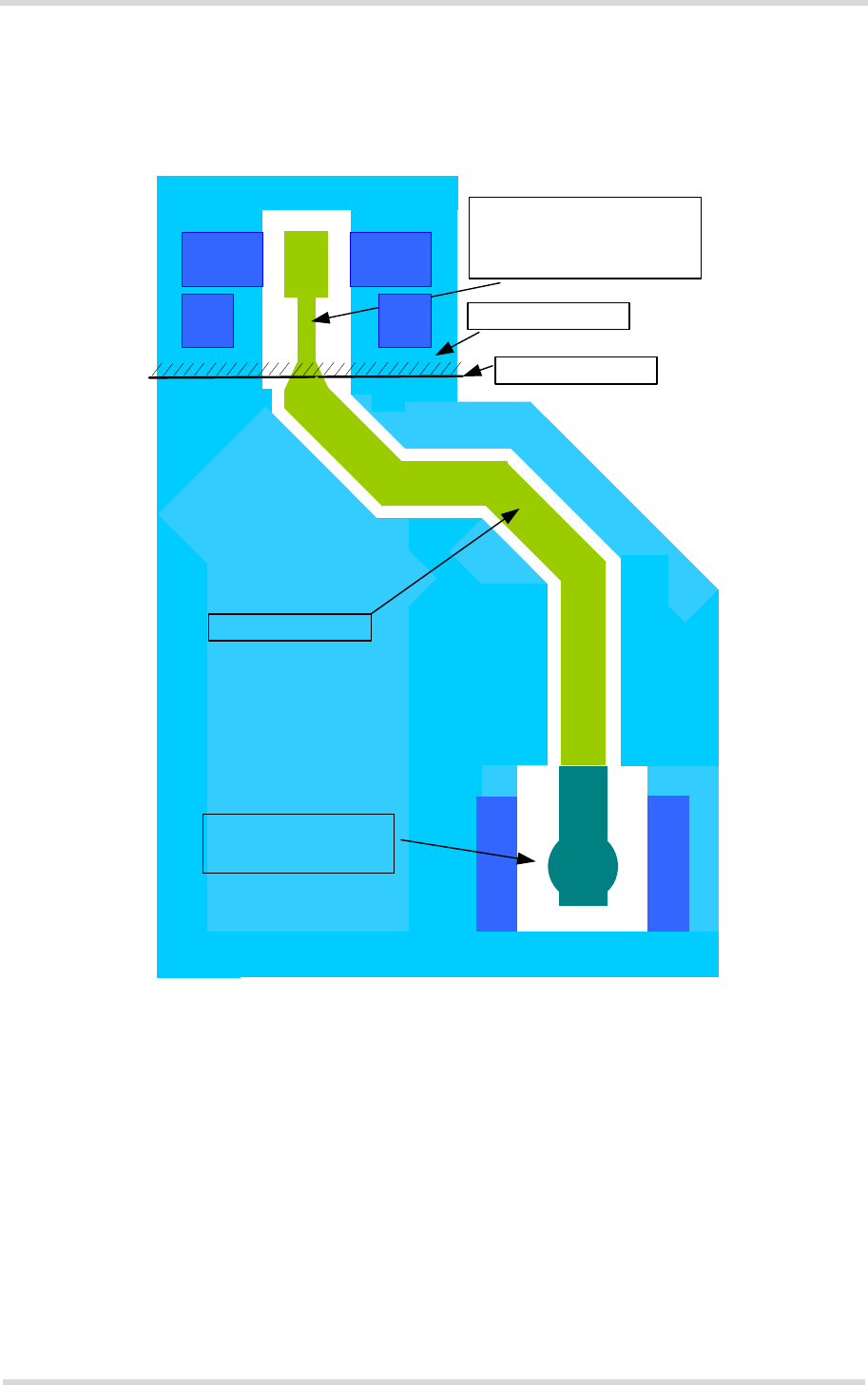
Cinterion® PLAS9-X Hardware Interface Overview
2.2 GSM/UMTS/LTE Antenna Interface
22
PLAS9-X_HIO_v00.044 2017-09-19
Confidential / Preliminary
Page 20 of 39
Figure 8 shows a further sample connection of an evaluation module‘s antenna pad at the bot-
tom layer of the PLAS9-X evaluation module PCB with the PCB‘s coaxial antenna connector.
The PLAS9-X evaluation module is part of the reference equipment used by Gemalto M2M for
type approval (see also Section 5.3).
Figure 8: Routing to PLAS9-X evaluation module‘s RF connector
e.g.
Ant_
WGSM
G N D G N D
Ground Connection
Stripline (50 ohms) on top
layer of evaluation board from
antenna pad to module edge
Width = 0,40 mm
G N DG N D
G N D G N D
Edge of Module PCB
E.g. U.FL
antennaconnector
50 ohms micro stripline

Cinterion® PLAS9-X Hardware Interface Overview
2.3 Sample Application
22
PLAS9-X_HIO_v00.044 2017-09-19
Confidential / Preliminary
Page 21 of 39
2.3 Sample Application
Figure 9 shows a typical example of how to integrate an PLAS9-X module with an application.
The PWR_IND line is an open collector that needs an external pull-up resistor which connects
to the voltage supply VCC µC of the microcontroller. Low state of the open collector pulls the
PWR_IND signal low and indicates that the PLAS9-X module is active, high level notifies the
Power Down mode.
If the module is in Power Down mode avoid current flowing from any other source into the mod-
ule circuit, for example reverse current from high state external control lines. Therefore, the
controlling application must be designed to prevent reverse flow.
While developing SMT applications it is strongly recommended to provide test points
for certain signals, i.e., lines to and from the module - for debug and/or test purposes.
The SMT application should allow for an easy access to these signals. For details on
how to implement test points see [3].
The EMC measures are best practice recommendations. In fact, an adequate EMC strategy for
an individual application is very much determined by the overall layout and, especially, the po-
sition of components.
Some LGA pads are connected to clocks or high speed data streams that might interfere with
the module’s antenna. The RF receiver would then be blocked at certain frequencies (self in-
terference). The external application’s PCB tracks connected to these pads should therefore
be well shielded or kept away from the antenna. This applies especially to the USB and UICC/
SIM interfaces.
Disclaimer:
No warranty, either stated or implied, is provided on the sample schematic diagram shown in
Figure 9 and the information detailed in this section. As functionality and compliance with na-
tional regulations depend to a great amount on the used electronic components and the indi-
vidual application layout manufacturers are required to ensure adequate design and operating
safeguards for their products using PLAS9-X modules.

Cinterion® PLAS9-X Hardware Interface Overview
3 Operating Characteristics
24
PLAS9-X_HIO_v00.044 2017-09-19
Confidential / Preliminary
Page 23 of 39
3 Operating Characteristics
3.1 Operating Modes
The table below briefly summarizes the various operating modes referred to throughout the
document.
Table 3: Overview of operating modes
Mode Function
Normal
operation GSM / GPRS /
UMTS / HSPA /
LTE SLEEP
Power saving set automatically when no call is in progress and the USB
connection is detached.
GSM / GPRS /
UMTS / HSPA /
LTE IDLE
Power saving disabled or an USB connection active, but no data trans-
fer in progress.
GPRS DATA GPRS data transfer in progress. Power consumption depends on net-
work settings (e.g. power control level), uplink / downlink data rates and
GPRS configuration (e.g. used multislot settings).
EGPRS DATA EGPRS data transfer in progress. Power consumption depends on net-
work settings (e.g. power control level), uplink / downlink data rates and
EGPRS configuration (e.g. used multislot settings).
UMTS DATA UMTS data transfer in progress. Power consumption depends on net-
work settings (e.g. TPC Pattern) and data transfer rate.
HSPA DATA HSPA data transfer in progress. Power consumption depends on net-
work settings (e.g. TPC Pattern) and data transfer rate.
LTE DATA LTE data transfer in progress. Power consumption depends on network
settings (e.g. TPC Pattern) and data transfer rate.
Power
Down Normal shutdown after sending the AT^SMSO command. Software is not active. Interfaces
are not accessible. Operating voltage (connected to BATT+) remains applied. Only a volt-
age regulator is active for powering the RTC, as long as operating voltage applied at BATT+
does not drop below approx. 1.4V.
Airplane
mode Airplane mode shuts down the radio part of the module, causes the module to log off from
the GSM/GPRS network and disables all AT commands whose execution requires a radio
connection.
Airplane mode can be controlled by AT command (see [1]).
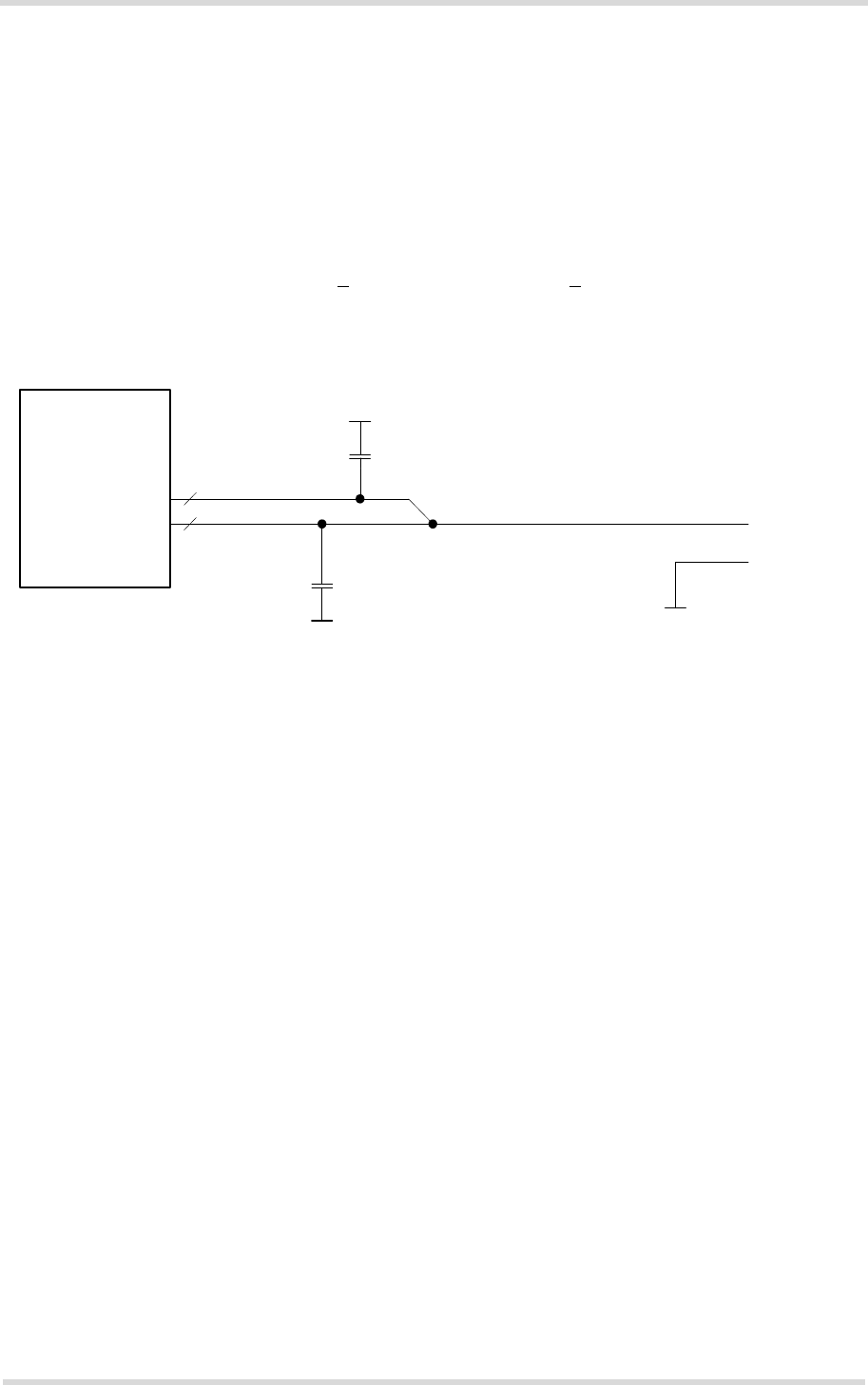
Cinterion® PLAS9-X Hardware Interface Overview
3.2 Power Supply
24
PLAS9-X_HIO_v00.044 2017-09-19
Confidential / Preliminary
Page 24 of 39
3.2 Power Supply
PLAS9-X needs to be connected to a power supply at the SMT application interface - 4 lines
BATT+, and GND. There are two separate voltage domains for BATT+:
• BATT+_RF with 2 lines for the RF power amplifier supply
• BATT+ with 2 lines for the general power management.
The main power supply from an external application has to be a single voltage source and has
to be expanded to two sub paths (star structure). Each voltage domain must be decoupled by
application with low ESR capacitors (> 47µF MLCC @ BATT+; > 4x47µF MLCC @ BATT+_RF)
as close as possible to LGA pads. Figure 10 shows a sample circuit for decoupling capacitors
for BATT+.
Figure 10: Decoupling capacitor(s) for BATT+
The power supply of PLAS9-X must be able to provide the peak current during the uplink trans-
mission.
All key functions for supplying power to the device are handled by the power management IC.
It provides the following features:
• Stabilizes the supply voltages for the baseband using switching regulators and low drop lin-
ear voltage regulators.
• Switches the module's power voltages for the power-up and -down procedures.
• Delivers, across the VEXT line, a regulated voltage for an external application.
• LDO to provide SIM power supply.
BATT+
2
2
Decoupling capacitors
e.g. 47µF X5R MLCC
4x
GND
BATT+
BATT+_RF
Module
SMT interface 1x
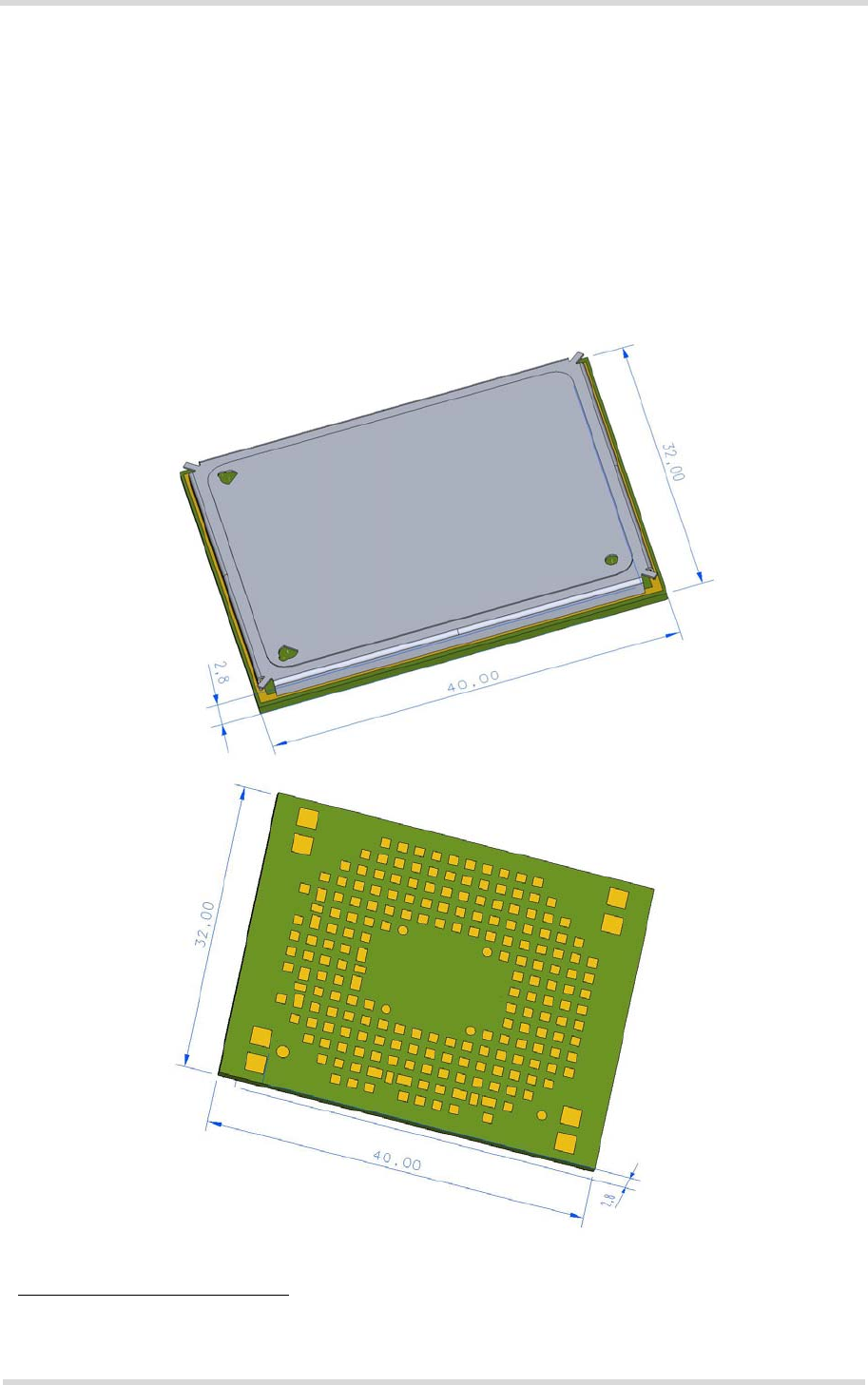
Cinterion® PLAS9-X Hardware Interface Overview
4 Mechanical Dimensions
26
PLAS9-X_HIO_v00.044 2017-09-19
Confidential / Preliminary
Page 25 of 39
4 Mechanical Dimensions
4.1 Mechanical Dimensions of PLAS9-X
Figure 11 shows a 3D view1 of PLAS9-X and provides an overview of the board's mechanical
dimensions. For further details see Figure 12.
Length: 40mm
Width: 32mm
Height: 2.8mm
Figure 11: PLAS9-X – top and bottom view
1. The coloring of the 3D view does not reflect the module’s real color.
Top view
Bottom view

Cinterion® PLAS9-X Hardware Interface Overview
5 Regulatory and Type Approval Information
32
PLAS9-X_HIO_v00.044 2017-09-19
Confidential / Preliminary
Page 27 of 39
5 Regulatory and Type Approval Information
Note that some regulatory and type approval information is still to be defined.
5.1 Directives and Standards
PLAS9-X has been designed to comply with the directives and standards listed below.
It is the responsibility of the application manufacturer to ensure compliance of the final product
with all provisions of the applicable directives and standards as well as with the technical spec-
ifications provided in the "PLAS9-X Hardware Interface Description".1
1. Manufacturers of applications which can be used in the US shall ensure that their applications have a
PTCRB approval. For this purpose they can refer to the PTCRB approval of the respective module.
Table 4: Directives
2002/95/EC (RoHS 1)
2011/65/EC (RoHS 2) Directive of the European Parliament and of the Council of
27 January 2003 (and revised on 8 June 2011) on the
restriction of the use of certain hazardous substances in
electrical and electronic equipment (RoHS)
Table 5: Standards of North American type approval
CFR Title 47 Code of Federal Regulations, Part 22, Part 24; US Equipment Authorization
FCC
OET Bulletin 65
(Edition 97-01) Evaluating Compliance with FCC Guidelines for Human Exposure to
Radiofrequency Electromagnetic Fields
UL 60 950-1 Product Safety Certification (Safety requirements)
NAPRD.03 V5.32 Overview of PCS Type certification review board Mobile Equipment Type
Certification and IMEI control
PCS Type Certification Review board (PTCRB)
RSS132, RSS133,
RSS139 Canadian Standard
Table 6: Requirements of quality
IEC 60068 Environmental testing
DIN EN 60529 IP codes
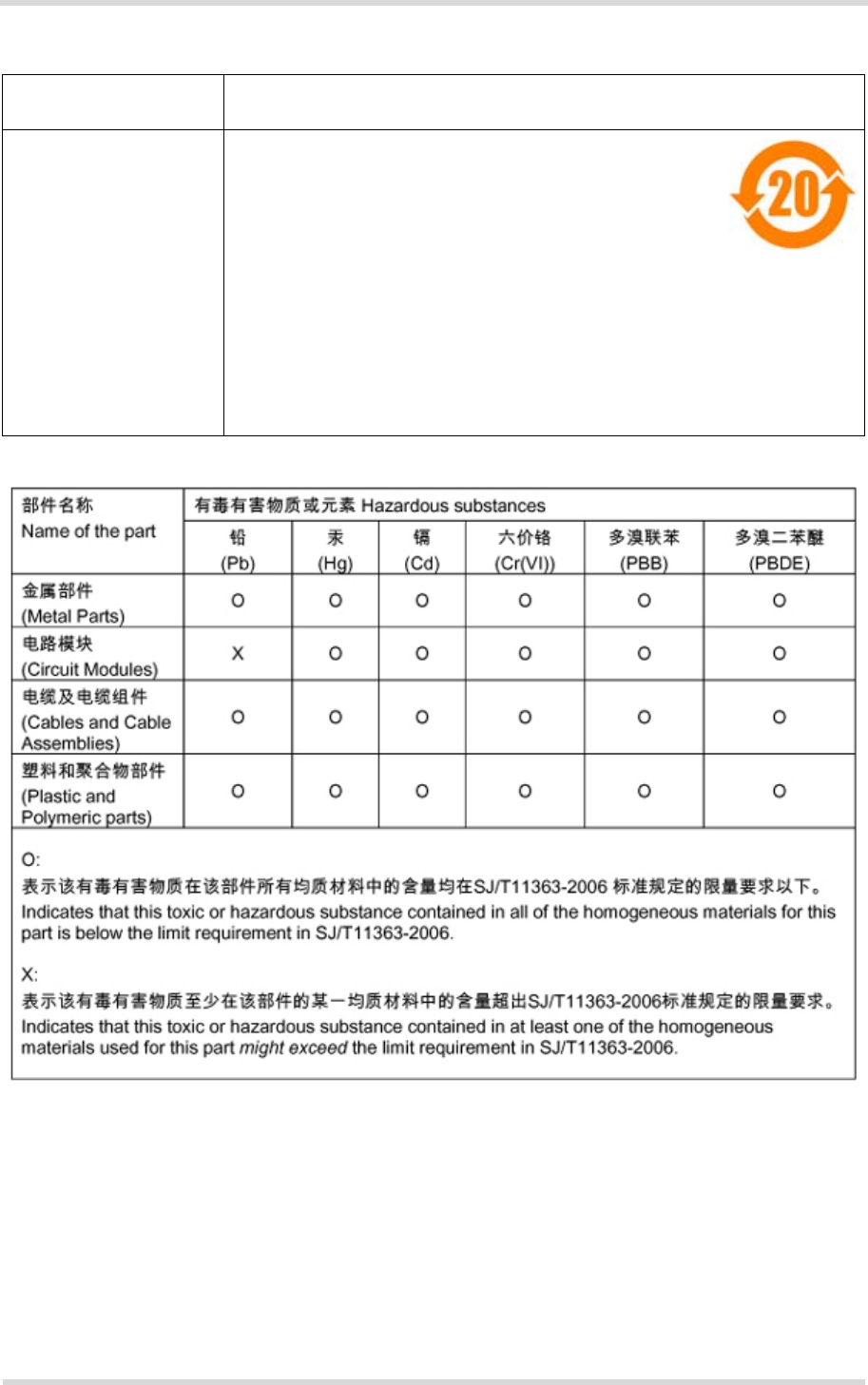
Cinterion® PLAS9-X Hardware Interface Overview
5.1 Directives and Standards
32
PLAS9-X_HIO_v00.044 2017-09-19
Confidential / Preliminary
Page 28 of 39
Table 8: Toxic or hazardous substances or elements with defined concentration limits
Table 7: Standards of the Ministry of Information Industry of the People’s Republic of China
SJ/T 11363-2006 “Requirements for Concentration Limits for Certain Hazardous Substances
in Electronic Information Products” (2006-06).
SJ/T 11364-2006 “Marking for Control of Pollution Caused by Electronic
Information Products” (2006-06).
According to the “Chinese Administration on the Control of
Pollution caused by Electronic Information Products”
(ACPEIP) the EPUP, i.e., Environmental Protection Use
Period, of this product is 20 years as per the symbol
shown here, unless otherwise marked. The EPUP is valid only as long as
the product is operated within the operating limits described in the Hardware
Interface Description.
Please see Table 8 for an overview of toxic or hazardous substances or ele-
ments that might be contained in product parts in concentrations above the
limits defined by SJ/T 11363-2006.

Cinterion® PLAS9-X Hardware Interface Overview
5.2 SAR requirements specific to portable mobiles
32
PLAS9-X_HIO_v00.044 2017-09-19
Confidential / Preliminary
Page 29 of 39
5.2 SAR requirements specific to portable mobiles
Mobile phones, PDAs or other portable transmitters and receivers incorporating a GSM module
must be in accordance with the guidelines for human exposure to radio frequency energy. This
requires the Specific Absorption Rate (SAR) of portable PLAS9-X based applications to be
evaluated and approved for compliance with national and/or international regulations.
Since the SAR value varies significantly with the individual product design manufacturers are
advised to submit their product for approval if designed for portable use. For US markets the
relevant directives are mentioned below. It is the responsibility of the manufacturer of the final
product to verify whether or not further standards, recommendations or directives are in force
outside these areas.
Products intended for sale on US markets
ES 59005/ANSI C95.1 Considerations for evaluation of human exposure to electromagnetic
fields (EMFs) from mobile telecommunication equipment (MTE) in the
frequency range 30MHz - 6GHz
IMPORTANT:
Manufacturers of portable applications based on PLAS9-X modules are required to have their
final product certified and apply for their own FCC Grant and Industry Canada Certificate relat-
ed to the specific portable mobile.
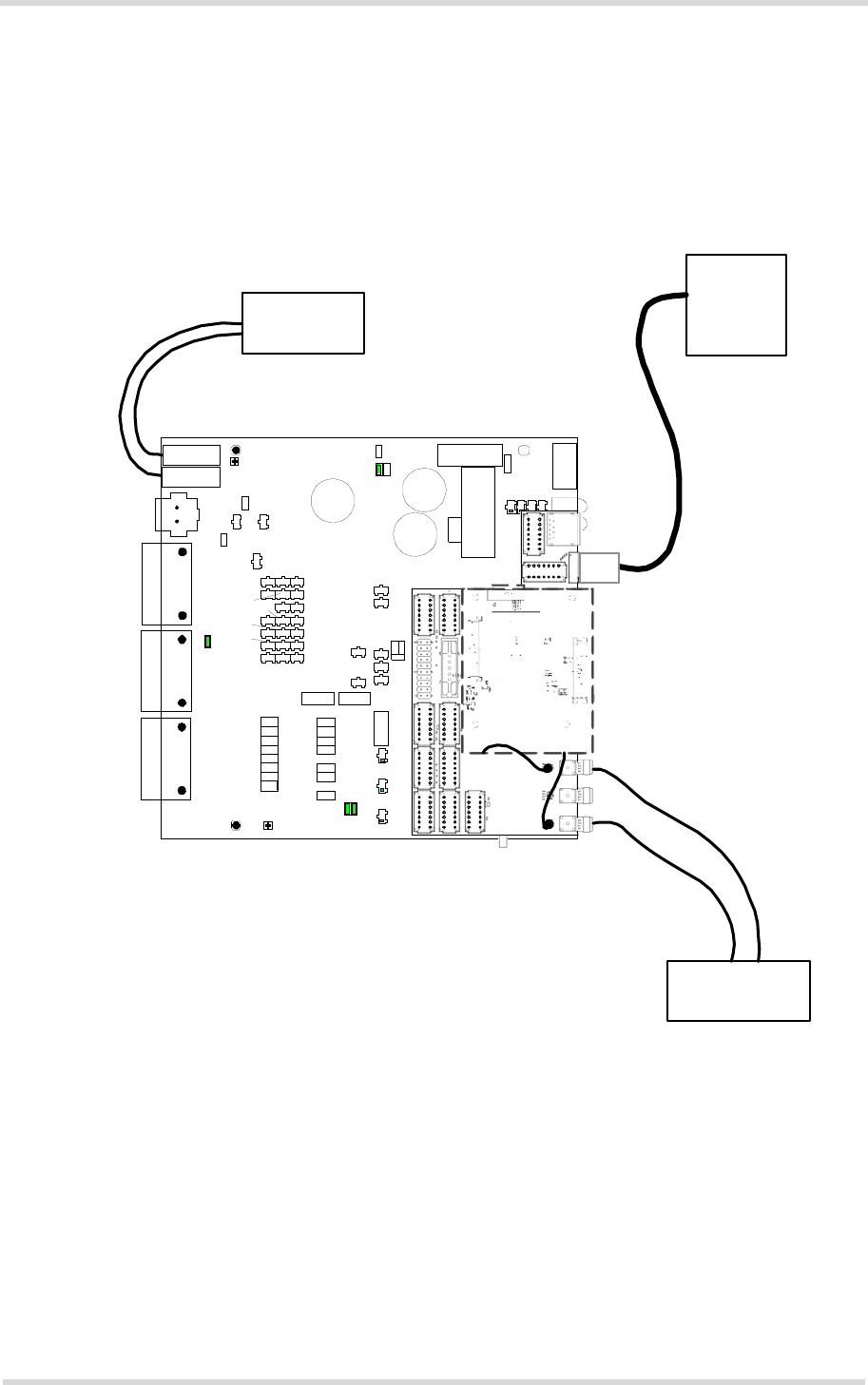
Cinterion® PLAS9-X Hardware Interface Overview
5.3 Reference Equipment for Type Approval
32
PLAS9-X_HIO_v00.044 2017-09-19
Confidential / Preliminary
Page 30 of 39
5.3 Reference Equipment for Type Approval
The Gemalto M2M general reference setup submitted to type approve PLAS9-X is shown in
the figure below: Figure 13 illustrates the setup for general tests and evaluation purposes. The
evaluation module can be plugged directly onto the ALAS6A-DSB75 adapter. The GSM/UMTS/
LTE test equipment is still connected via SMA connectors on the ALAS6A-DSB75 adapter. The
PC is connected via USB interface.
Figure 13: Reference equipment for type approval
Please note that for EMC and RF performance tests, slightly different reference equipment con-
figurations are used. If necessary, please contact Gemalto for further details.
V
10 6
43 1X506
X202 X201 X 205
X400X401
X110
X120
S112
S110
X121
S111
C4 13
X410
X411
X405
C415
C414
X510
X511
X5 51X552
X122
S601
X602
X710
TP105
X700
S714
S715
S710
S711
V430
X505
S201 S200
X554
X703
X561
S504S503
S502
S501
S500
S457S452
S456
S455
S453
S454
S450
S460
S451
S461
S462
S464
S465
S463
S466
S469
S459
S467
S458S468
1
2
31
2
31
2
3
1
10
12
3
1
2
3
1
2
3
12
3
1
2
3
1
2
3
1
2
3
13
13
13
1
1
5
1
12
3
1
1
1
2
3
12
3
12
3
1
2
3
12
3
12
3
1
2
3
12
3
12
3
1
2
3
12
3
12
3
12
3
12
3
1
2
3
1
2
3
12
3
1
2
3
12
3
12
3
1
2
3
1
2
3
1
2
3
1
1
11
1
11
1 4 2 3
15
69
15
69
15
69
11
2
2
910
910
2
9
X203
1
X206
X204
1
1
DSB75
3
V237
V232
V236
V231
V235
V230
V234
V244
V243
V242
V241
V239
V240
V238
V233
SYNC
RTS0
DSR0
DTR0
DCD0
RING0
TXD0
CTS0
RXD0
ALAS6A-
DSB75-
Adapter
W
EVAL-Board
with module
Power Supply
PC
GSM / UMTS / LTE
Testequipment
USB 3.0
GSM/UMTS/
LTE
UMTS /LTE
Rx Diversity /
MIMO

Cinterion® PLAS9-X Hardware Interface Overview
5.4 Compliance with FCC and IC Rules and Regulations
32
PLAS9-X_HIO_v00.044 2017-09-19
Confidential / Preliminary
Page 31 of 39
5.4 Compliance with FCC and IC Rules and Regulations
The Equipment Authorization Certification for the Gemalto M2M modules reference application
described in Section 5.3 will be registered under the following identifiers:
•PLAS9-X:
FCC Identifier QIPPLAS9-X
Industry Canada Certification Number: 7830A-PLAS9X
Granted to Gemalto M2M GmbH
Manufacturers of mobile or fixed devices incorporating PLAS9-X modules are authorized to
use the FCC Grants and Industry Canada Certificates of the PLAS9-X modules for their own
final products according to the conditions referenced in these documents. In this case, the FCC
label of the module shall be visible from the outside, or the host device shall bear a second label
stating "Contains FCC ID: QIPPLAS9-X" and accordingly “Contains IC: 7830A-PLAS9X“. The
integration is limited to fixed or mobile categorized host devices, where a separation distance
between the antenna and any person of min. 20cm can be assured during normal operating
conditions.
For mobile and fixed operation configurations the antenna gain, including cable loss, must not
exceed the limits listed in the following Table 9 for FCC and IC.
IMPORTANT:
Manufacturers of portable applications incorporating PLAS9-X modules are required to have
their final product certified and apply for their own FCC Grant and Industry Canada Certificate
related to the specific portable mobile. This is mandatory to meet the SAR requirements for por-
table mobiles (see Section 5.2 for detail).
Changes or modifications not expressly approved by the party responsible for compliance
could void the user's authority to operate the equipment.
Table 9: Antenna gain limits for FCC and IC (TBD.)
Maximum gain in operating band FCC limit IC limit Unit
Band12, Band13, Band 29 700MHz (LTE) dBi
Band 5, 850MHz (GSM/WCDMA/LTE) dBi
Band 4, 1700MHz (WCDMA/LTE) dBi
Band 2, 1900MHz (GSM/WCDMA/LTE) dBi

Cinterion® PLAS9-X Hardware Interface Overview
5.4 Compliance with FCC and IC Rules and Regulations
32
PLAS9-X_HIO_v00.044 2017-09-19
Confidential / Preliminary
Page 32 of 39
Note: This equipment has been tested and found to comply with the limits for a Class B digital
device, pursuant to part 15 of the FCC Rules and with Industry Canada license-exempt RSS
standard(s). These limits are designed to provide reasonable protection against harmful inter-
ference in a residential installation. This equipment generates, uses and can radiate radio fre-
quency energy and, if not installed and used in accordance with the instructions, may cause
harmful interference to radio communications. However, there is no guarantee that interference
will not occur in a particular installation. If this equipment does cause harmful interference to
radio or television reception, which can be determined by turning the equipment off and on, the
user is encouraged to try to correct the interference by one or more of the following measures:
• Reorient or relocate the receiving antenna.
• Increase the separation between the equipment and receiver.
• Connect the equipment into an outlet on a circuit different from that to which the receiver
is connected.
• Consult the dealer or an experienced radio/TV technician for help.
This Class B digital apparatus complies with Canadian ICES-003.
If Canadian approval is requested for devices incorporating PLAS9-X modules the above note
will have to be provided in the English and French language in the final user documentation.
Manufacturers/OEM Integrators must ensure that the final user documentation does not con-
tain any information on how to install or remove the module from the final product.

Cinterion® PLAS9-X Hardware Interface Overview
6 Document Information
36
PLAS9-X_HIO_v00.044 2017-09-19
Confidential / Preliminary
Page 33 of 39
6 Document Information
6.1 Revision History
New document: "Cinterion® PLAS9-X Hardware Interface Overview" Version 00.044
6.2 Related Documents
[1] PLAS9-X AT Command Set
[2] PLAS9-X Release Note
[3] Application Note 48: SMT Module Integration
[4] Universal Serial Bus Specification Revision 3.0
[5] Universal Serial Bus Specification Revision 2.0
6.3 Terms and Abbreviations
Chapter What is new
-- Initial document setup.
Abbreviation Description
ANSI American National Standards Institute
ARP Antenna Reference Point
CA Carrier Aggregation
CE Conformité Européene (European Conformity)
CS Coding Scheme
CS Circuit Switched
CSD Circuit Switched Data
DL Download
dnu Do not use
DRX Discontinuous Reception
DSB Development Support Board
DTX Discontinuous Transmission
EDGE Enhanced Data rates for GSM Evolution
EGSM Extended GSM
EMC Electromagnetic Compatibility
ESD Electrostatic Discharge
ETS European Telecommunication Standard

Cinterion® PLAS9-X Hardware Interface Overview
6.3 Terms and Abbreviations
36
PLAS9-X_HIO_v00.044 2017-09-19
Confidential / Preliminary
Page 34 of 39
ETSI European Telecommunications Standards Institute
FCC Federal Communications Commission (U.S.)
FDD Frequency Division Duplex
GPRS General Packet Radio Service
GSM Global Standard for Mobile Communications
HiZ High Impedance
HSDPA High Speed Downlink Packet Access
I/O Input/Output
IMEI International Mobile Equipment Identity
ISO International Standards Organization
ITU International Telecommunications Union
kbps kbits per second
LED Light Emitting Diode
LGA Land Grid Array
LTE Long term evolution
MBB Moisture barrier bag
Mbps Mbits per second
MCS Modulation and Coding Scheme
MFBI Multiple Frequency Band Indicator
MIMO Multiple Input Multiple Output
MLCC Multi Layer Ceramic Capacitor
MO Mobile Originated
MS Mobile Station, also referred to as TE
MSL Moisture Sensitivity Level
MT Mobile Terminated
nc Not connected
NTC Negative Temperature Coefficient
PCB Printed Circuit Board
PCL Power Control Level
PCS Personal Communication System, also referred to as GSM 1900
PD Pull Down resistor
PDU Protocol Data Unit
PS Packet Switched
PSK Phase Shift Keying
PU Pull Up resistor
QAM Quadrature Amplitude Modulation
Abbreviation Description

Cinterion® PLAS9-X Hardware Interface Overview
6.3 Terms and Abbreviations
36
PLAS9-X_HIO_v00.044 2017-09-19
Confidential / Preliminary
Page 35 of 39
R&TTE Radio and Telecommunication Terminal Equipment
RF Radio Frequency
rfu Reserved for future use
ROPR Radio Output Power Reduction
RTC Real Time Clock
Rx Receive Direction
SAR Specific Absorption Rate
SELV Safety Extra Low Voltage
SIM Subscriber Identification Module
SMD Surface Mount Device
SMS Short Message Service
SMT Surface Mount Technology
SRAM Static Random Access Memory
SRB Signalling Radio Bearer
TE Terminal Equipment
TPC Transmit Power Control
TS Technical Specification
Tx Transmit Direction
UL Upload
UMTS Universal Mobile Telecommunications System
URC Unsolicited Result Code
USB Universal Serial Bus
UICC USIM Integrated Circuit Card
USIM UMTS Subscriber Identification Module
WCDMA Wideband Code Division Multiple Access
Abbreviation Description
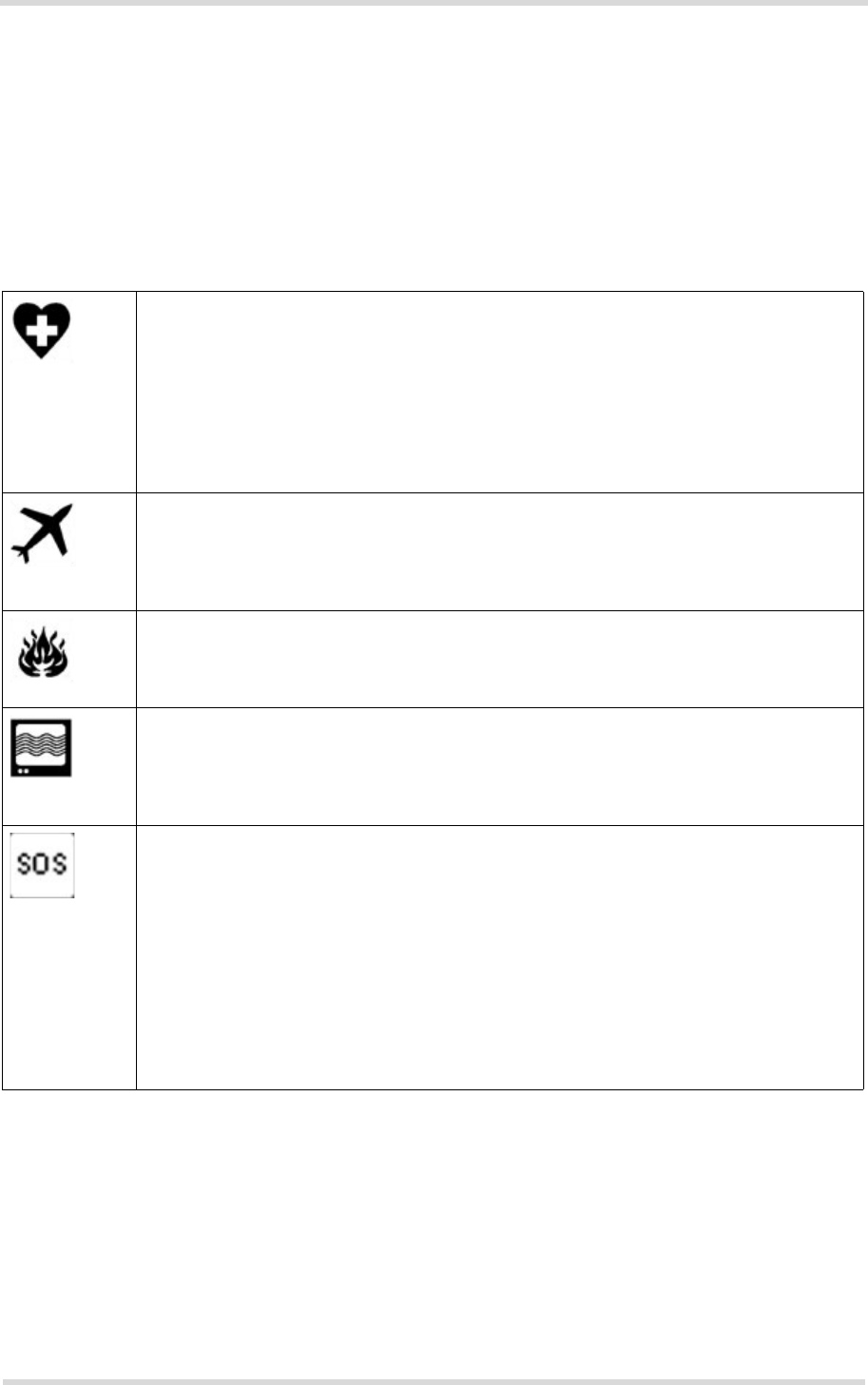
Cinterion® PLAS9-X Hardware Interface Overview
6.4 Safety Precaution Notes
36
PLAS9-X_HIO_v00.044 2017-09-19
Confidential / Preliminary
Page 36 of 39
6.4 Safety Precaution Notes
The following safety precautions must be observed during all phases of the operation, usage,
service or repair of any cellular terminal or mobile incorporating PLAS9-X. Manufacturers of the
cellular terminal are advised to convey the following safety information to users and operating
personnel and to incorporate these guidelines into all manuals supplied with the product. Fail-
ure to comply with these precautions violates safety standards of design, manufacture and in-
tended use of the product. Gemalto M2M assumes no liability for customer’s failure to comply
with these precautions.
When in a hospital or other health care facility, observe the restrictions on the use of
mobiles. Switch the cellular terminal or mobile off, if instructed to do so by the guide-
lines posted in sensitive areas. Medical equipment may be sensitive to RF energy.
The operation of cardiac pacemakers, other implanted medical equipment and hear-
ing aids can be affected by interference from cellular terminals or mobiles placed close
to the device. If in doubt about potential danger, contact the physician or the manufac-
turer of the device to verify that the equipment is properly shielded. Pacemaker
patients are advised to keep their hand-held mobile away from the pacemaker, while
it is on.
Switch off the cellular terminal or mobile before boarding an aircraft. Make sure it can-
not be switched on inadvertently. The operation of wireless appliances in an aircraft is
forbidden to prevent interference with communications systems. Failure to observe
these instructions may lead to the suspension or denial of cellular services to the
offender, legal action, or both.
Do not operate the cellular terminal or mobile in the presence of flammable gases or
fumes. Switch off the cellular terminal when you are near petrol stations, fuel depots,
chemical plants or where blasting operations are in progress. Operation of any elec-
trical equipment in potentially explosive atmospheres can constitute a safety hazard.
Your cellular terminal or mobile receives and transmits radio frequency energy while
switched on. Remember that interference can occur if it is used close to TV sets,
radios, computers or inadequately shielded equipment. Follow any special regulations
and always switch off the cellular terminal or mobile wherever forbidden, or when you
suspect that it may cause interference or danger.
IMPORTANT!
Cellular terminals or mobiles operate using radio signals and cellular networks.
Because of this, connection cannot be guaranteed at all times under all conditions.
Therefore, you should never rely solely upon any wireless device for essential com-
munications, for example emergency calls.
Remember, in order to make or receive calls, the cellular terminal or mobile must be
switched on and in a service area with adequate cellular signal strength.
Some networks do not allow for emergency calls if certain network services or phone
features are in use (e.g. lock functions, fixed dialing etc.). You may need to deactivate
those features before you can make an emergency call.
Some networks require that a valid SIM card be properly inserted in the cellular termi-
nal or mobile.

Cinterion® PLAS9-X Hardware Interface Overview
7 Appendix
38
PLAS9-X_HIO_v00.044 2017-09-19
Confidential / Preliminary
Page 37 of 39
7 Appendix
7.1 List of Parts and Accessories
Table 10: List of parts and accessories
Description Supplier Ordering information
PLAS9-X Gemalto M2M Standard module
Gemalto M2M IMEI:
Packaging unit (ordering) number:
L30960-N5130-B100
Module label number:
L30960-N5130-B100-11
1. Note: At the discretion of Gemalto M2M, module label information can either be laser engraved on the
module’s shielding or be printed on a label adhered to the module’s shielding.
PLAS9-X Evaluation module Gemalto M2M Ordering number: TBD. (PLAS9)
DSB75 Support Box Gemalto M2M Ordering number: L36880-N8811-A100
Votronic Handset VOTRONIC /
Gemalto M2M Gemalto M2M ordering number: L36880-N8301-A107
Votronic ordering number: HH-SI-30.3/V1.1/0
Votronic
Entwicklungs- und Produktionsgesellschaft für elek-
tronische Geräte mbH
Saarbrücker Str. 8
66386 St. Ingbert
Germany
Phone: +49-(0)6 89 4 / 92 55-0
Fax: +49-(0)6 89 4 / 92 55-88
Email: contact@votronic.com
SIM card holder incl. push
button ejector and slide-in
tray
Molex Ordering numbers: 91228
91236
Sales contacts are listed in Table 11.
U.FL antenna connector Molex or
Hirose Sales contacts are listed in Table 11 and Table 12.

Cinterion® PLAS9-X Hardware Interface Overview
7.1 List of Parts and Accessories
38
PLAS9-X_HIO_v00.044 2017-09-19
Confidential / Preliminary
Page 38 of 39
Table 11: Molex sales contacts (subject to change)
Molex
For further information please click:
http://www.molex.com
Molex Deutschland GmbH
Otto-Hahn-Str. 1b
69190 Walldorf
Germany
Phone: +49-6227-3091-0
Fax: +49-6227-3091-8100
Email: mxgermany@molex.com
American Headquarters
Lisle, Illinois 60532
U.S.A.
Phone: +1-800-78MOLEX
Fax: +1-630-969-1352
Molex China Distributors
Beijing,
Room 1311, Tower B, COFCO Plaza
No. 8, Jian Guo Men Nei Street, 100005
Beijing
P.R. China
Phone: +86-10-6526-9628
Fax: +86-10-6526-9730
Molex Singapore Pte. Ltd.
110, International Road
Jurong Town,
Singapore 629174
Phone: +65-6-268-6868
Fax: +65-6-265-6044
Molex Japan Co. Ltd.
1-5-4 Fukami-Higashi,
Yamato-City,
Kanagawa, 242-8585
Japan
Phone: +81-46-265-2325
Fax: +81-46-265-2365
Table 12: Hirose sales contacts (subject to change)
Hirose Ltd.
For further information please click:
http://www.hirose.com
Hirose Electric (U.S.A.) Inc
2688 Westhills Court
Simi Valley, CA 93065
U.S.A.
Phone: +1-805-522-7958
Fax: +1-805-522-3217
Hirose Electric Europe B.V.
German Branch:
Herzog-Carl-Strasse 4
73760 Ostfildern
Germany
Phone: +49-711-456002-1
Fax: +49-711-456002-299
Email: info@hirose.de
Hirose Electric Europe B.V.
UK Branch:
First Floor, St. Andrews House,
Caldecotte Lake Business Park,
Milton Keynes MK7 8LE
Great Britain
Phone: +44-1908-369060
Fax: +44-1908-369078
Hirose Electric Co., Ltd.
5-23, Osaki 5 Chome,
Shinagawa-Ku
Tokyo 141
Japan
Phone: +81-03-3491-9741
Fax: +81-03-3493-2933
Hirose Electric Europe B.V.
Hogehillweg 8
1101 CC Amsterdam Z-O
Netherlands
Phone: +31-20-6557-460
Fax: +31-20-6557-469

39
GEMALTO.COM/M2M
About Gemalto
Since 1996, Gemalto has been pioneering groundbreaking M2M and IoT products that keep our
customers on the leading edge of innovation.
We work closely with global mobile network operators to ensure that Cinterion® modules evolve
in sync with wireless networks, providing a seamless migration path to protect your IoT technology
investment.
Cinterion products integrate seamlessly with Gemalto identity modules, security solutions and licensing
and monetization solutions, to streamline development timelines and provide cost efficiencies that
improve the bottom line.
As an experienced software provider, we help customers manage connectivity, security and
quality of service for the long lifecycle of IoT solutions.
For more information please visit
www.gemalto.com/m2m, www.facebook.com/gemalto, or Follow@gemaltoIoT on Twitter.
Gemalto M2M GmbH
Werinherstrasse 81
81541 Munich
Germany
© Gemalto 2017. All rights reserved. Gemalto, the Gemalto logo, are trademarks and service marks of Gemalto and are registered in certain countries.
